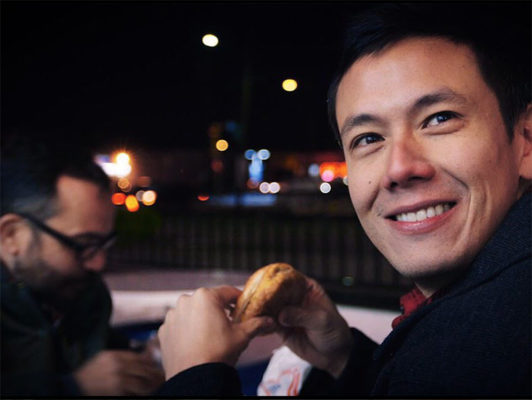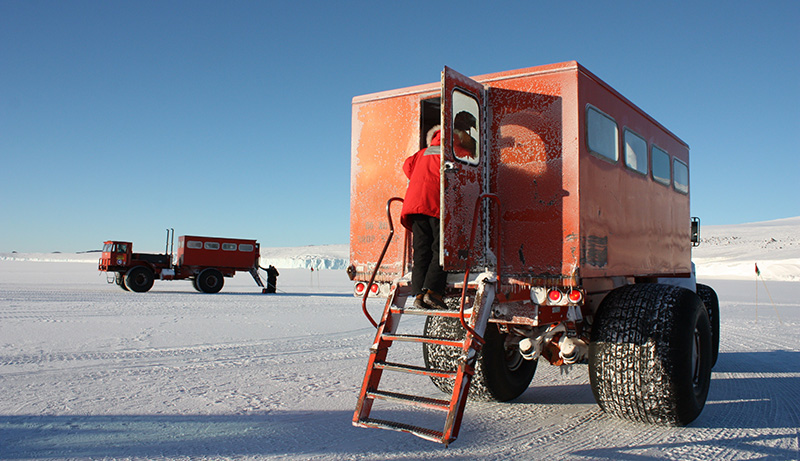
How to Work in Antarctica
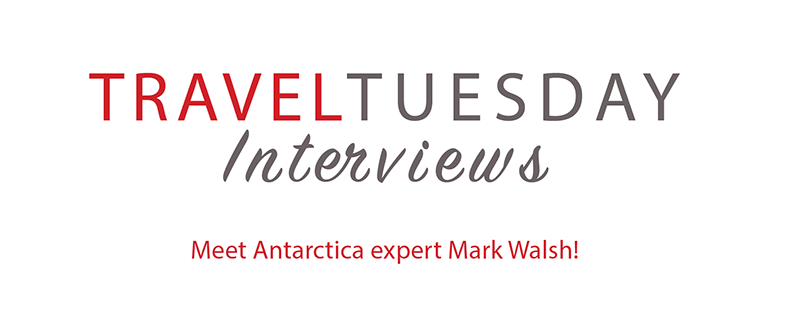
In this week’s Travel Tuesday Interview, I chat with Antarctica expert Mark Walsh. Mark has worked in Antarctica five seasons and dishes all the details about living on the continent. He also shares a link to his FREE ebook about working on “the ice.”
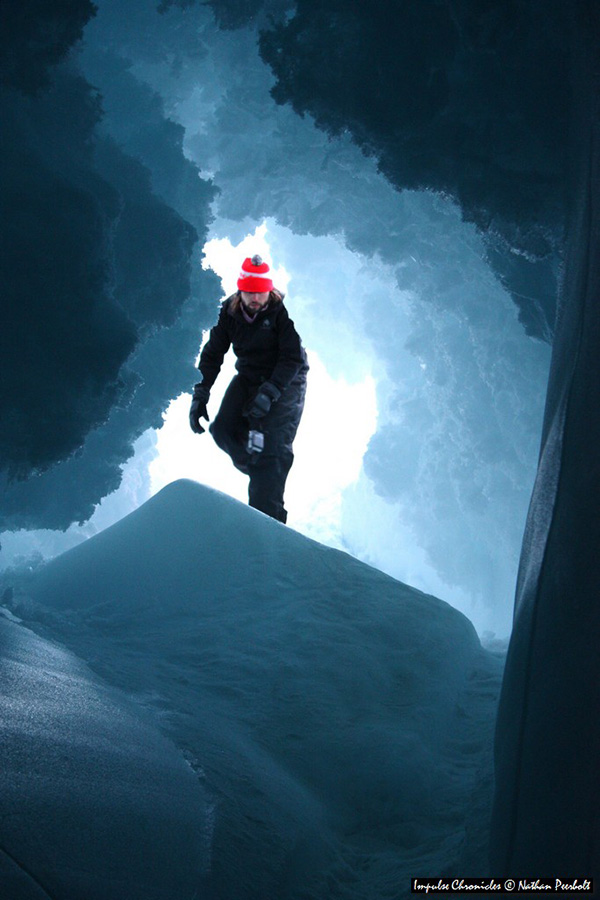
One of the main highlights of working in Antarctica for Mark Walsh is exploring Ice caves. Photo by Nate Peerbolt.
Name: Mark Walsh
Age: 35
Hometown: Moss Point, MS
Country count: 12
Blog/Website: www.markwalsh.co
1. How did you start traveling?
I was a pretty adventurous child. We would take extended bike, boat and camping trips from a pretty young age. I think that curiosity eventually extended into places farther from my initial stomping grounds along the Gulf Coast of Mississippi. I started moving away from home during the summers in high school, and then went far-off for college. Each time, I would come back as a better version of myself and always strived for lengthy and immersive travel experiences to help further that growth.
2. Tell us about how you end up working in Antarctica.
I found out about the US Antarctic Program (USAP) while working as an undergrad Research Assistant at the College of Charleston. My professor was familiar with the program and encouraged me to apply. I didn’t get far those first couple of years, and so I eventually flew to Denver where USAP’s main offices are located. I met with some hiring managers and came up with a plan – to become a weather observer. It took about a year to get certified as a weather observer, and then another three years working part-time at Mobile airport before gaining enough experience to actually get hired. My first trip to “the ice” [Antarctica] was in 2009, and I’ve been a total of five times now: three summers and two winters. It was a long process for me—five years from first application to deployment—but it was certainly worth it.
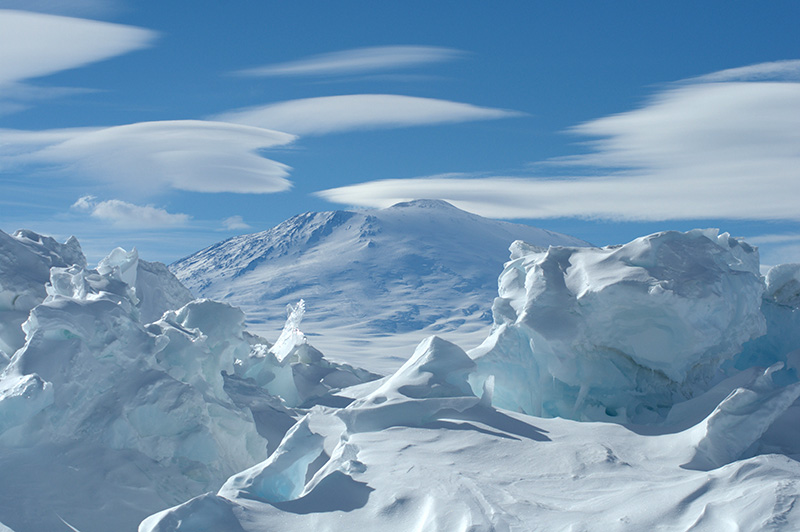
Antarctica is known for 24-hour daylight during the North American winter. Photo by Nate Peerbolt.
3. When is the best time to go to Antarctica?
Antarctica is most accessible during the Austral summer (October – March) when there is 24-hour daylight and relatively warm temperatures (+20 F). Most of the science happens during those months, so more jobs are available within the USAP and there are lots of people on the station. The cruise ships also operate during the summer for anyone who just wants to quickly visit the continent. Most people will see Antarctica during the summer; however, the Antarctic winter also brings job opportunities as well as unique experiences. The constant darkness, colder temperatures, and small working populations give the winter season a completely different feel. So, it really depends on what you’re looking for: the bright, fast-paced flurry of summer activity or the slower, darker, more personal-sabbatical feel of the winter. I suggest trying both.
4. What types of jobs are available in Antarctica?
There are many different jobs available in Antarctica. Basically, anything required to keep a small city operating is also required on the ice. This is especially true of blue-collar jobs and skilled labor. There are far fewer admin/computer jobs available, but they exist, as do other positions that do not require specific degrees or experience. However, these entry-level jobs tend to be more competitive. The pay for all jobs is about the same as you would get on mainland U.S. so it’s not a get-rich-quick scheme. But, people are generally able to save more money in Antarctica since room/ board are provided. I wrote a short guide about getting jobs in Antarctica that can be downloaded here for free. The guide provides a list of the different types of jobs available that range from carpenters to mechanics to chefs

Large trucks known as “Deltas” are used to transport people through the ice. A driver sits in the cab, and people climb up the back steps and sit along two long benched in the back. They have really large, wide tires so they don’t get stuck in the snow. Photo by Nate Peerbolt.
5. Share some tips for people wanting to work in Antarctica.
Apply. It’s awesome how much information is available on getting jobs in Antarctica today. This has not always been the case, which is one reason why it took me so long to get there. Sure, even today, you may not get hired on your first try. But, there is no reason that you can’t get a job doing something within a year or two. And rest assured, U.S. citizens have more opportunities to work in Antarctica than anyone on this planet because the U.S. Antarctic Program hires three to four times more people than any other countries’ Antarctic program. We are very fortunate.
6. What’s the average cost of a trip to Antarctica if you aren’t working there? Share some tips for getting there on a budget.
I’ve never actually paid money to go to Antarctica, so cannot say from actual experience. However, I do know that most people will take a cruise to Antarctica from South America so [they] will have to fly to Chile or Argentina ($1-2k). An average cruise will be about $4-6k per person, plus some gear, excursion costs, incidentals, etc. I would bet on $7-10k per person for a standard Antarctic experience. But like anything, the sky is the limit. I have heard of people hanging around Tierra Del Fuego and catching some last-minute cruise deals for about $2k.
[Update on Antarctica costs from TravelLikeAnna: The average cost is roughly $10,000 for a cruise if booked in advance with flights. There are a lot of last minute deals out of Ushuaia, Argentina, which is the main hub for cruises. When I was in Ushuaia, there were deals ranging from $7,500 to $5,000. But, I met a guy who just got back from a last-minute deal that was only $2,500. It is possible to get last minute deals, but you might have to hang out around Ushuaia for a while to get one. It’s not the cheapest place to hang out. The area is beautiful though with lots of fun things to do. Antarctica is possibly on my list for next year so I’ll post more details if/when I make it down there.]
But here’s the thing – you can bypass all this by working for the USAP. Not only are you being paid to go but are able to have experiences that money cannot buy. Want to go to the South Pole? Sure, there is a company can take you there. Just plan on spending $40-60k. Want to actually sleep in the South Pole station? Sorry, you have to work for the U.S. Antarctic Program. Otherwise, you’ll be outside in a tent. Granted, a very nice tent.
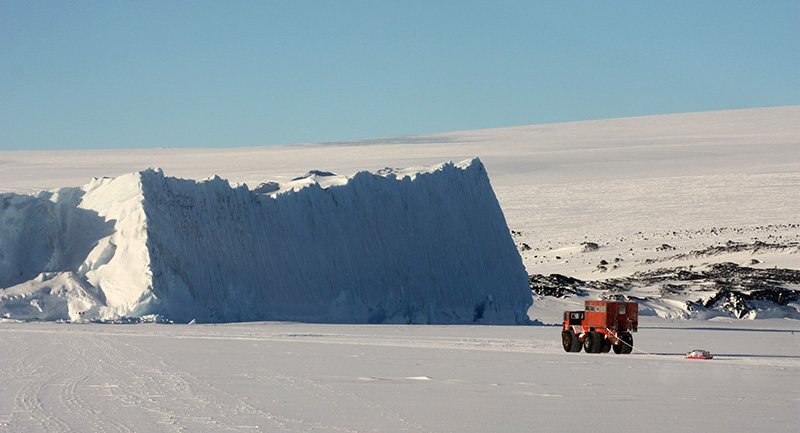
Rush hour in Antarctica. Photo by Nate Peerbolt.
7. Share one of your travel highlights in Antarctica.
There are so many. I mean, the entire experience of working in Antarctica is a highlight. I’ve enjoyed exploring ice caves, mountain biking, going to South Pole, visiting historic huts, seeing wildlife, conducting scientific research, performing at an outdoor music festival, polar plunging, flying in military aircraft, experiencing -61 F temperatures (not wind-chills), running a 5k, etc. But the fact is these day-to-day activities become routine, even in Antarctica! I think the best part of going to Antarctica is similar to what you experience whenever you relocate to a different environment. It’s the ability to create new habits and routines, to learn from new people and surroundings, and to ultimately leave as a better and more developed person. This is certainly possible in Antarctica, and is the thing to which I look most forward every time I go.
8. What is the biggest myth about Antarctica?
Aliens built pyramids there. I’m kidding… sort of. But that does seem to come across Facebook pretty regularly. Otherwise, I’m not sure people actually know that much about it. Most of the questions I get from people are pretty generic. Although, there does seem to be some confusion about penguins and polar bears. Polar Bears = Arctic = North Pole. Penguins = Antarctica = South Pole.
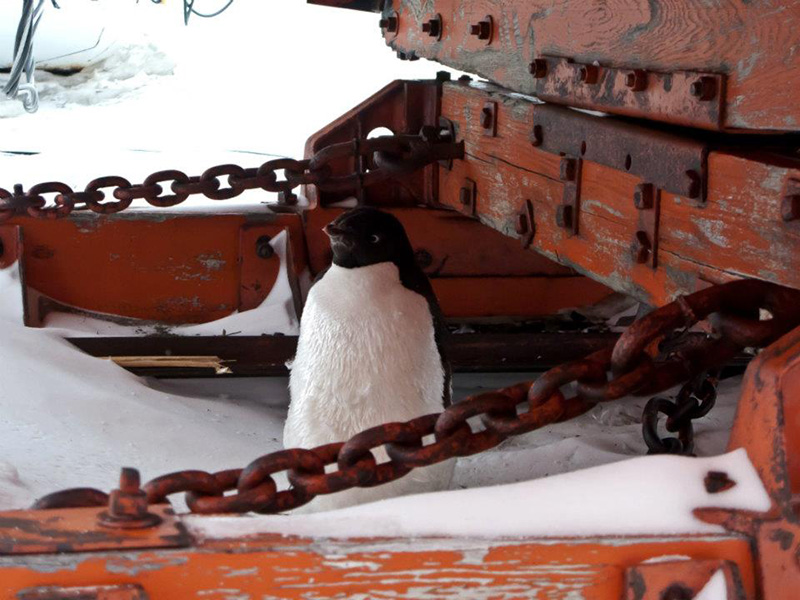
Mark Walsh jokes that the biggest misconception is that Antarctica has polar bears. Polar bears live in the North Pole and penguins live in the South Pole. Photo by Nate Peerbolt.
9. Name three things you always pack for Antarctica.
A sewing machine, indoor soccer shoes and a cordless phone.
One of the best things about working in Antarctica is the simplicity of life. You live on an island, both literally and figuratively. There are no cell phones (but we have pagers!) and have slow internet with landline telephones. Your room and board are provided, and most people don’t ever have to cook or clean. There is no commute to work, as your dorm is a short walk from everything: the cafeteria, gym, three bars, and rumor has it – a library (although I’ve never been there….I’m kidding. It’s nice and quaint with more books than you could ever read).
You typically work nine hour shifts, six days a week, but will find you actually have more free time than you would in the States. This gives you the opportunity to do many of the personal projects and recreational activities you may not otherwise be able to do. There are clubs to join, sports leagues to play, craft rooms to create, and bands to practice with. Most people’s creativity is allowed to flourish in this environment, and there is plenty of evidence that it does.
10. What is your next adventure?
Good question. I’m currently in Mississippi rebuilding a 38’ sailboat. I imagine I’ll have some warm-weather adventures between future trips to the ice.
__________________________________________
COMING UP NEXT
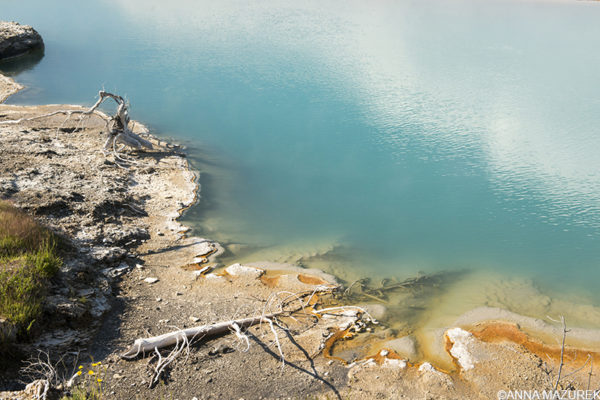
Best of 2017
Next week, I’ll wrap up 2017 with a recap of the most popular posts and adventures from the year to inspire your 2018 New Year’s travel resolutions! What are your travel resolutions for 2018?
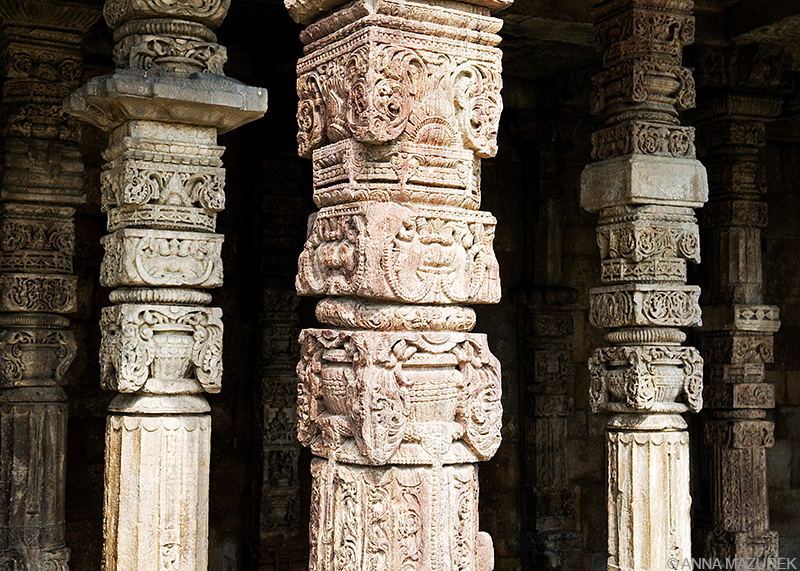
12 Places Not to Miss in India
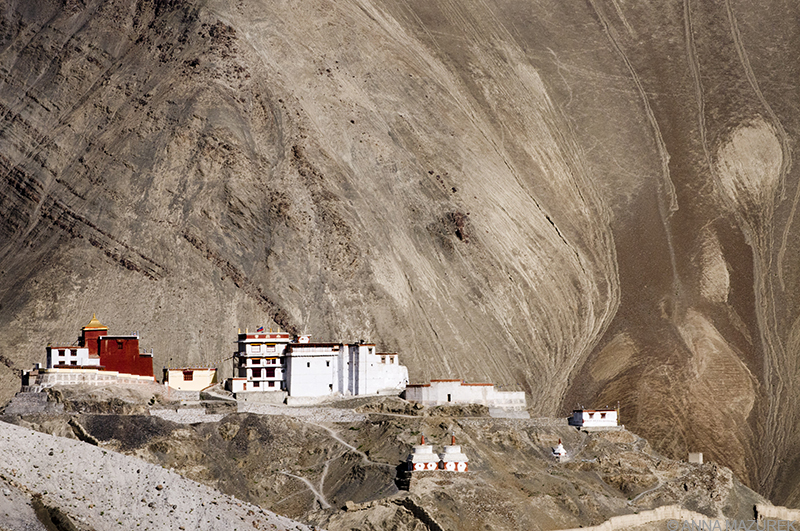
Temisgam Monastery, Ladakh, India
Traveling in India is the greatest adventure. Yes, it smells at times, but the scenery is so stunning it defies words. It will make you feel as if you stepped into a wall calendar. The poverty, heat and spices can be intense, but it’s worth every minute. The people will win you over with their kindness and resilience. There is no place in the world as intensely beautiful or complicated.
I’ve compiled a list of my favorite places—a mixture of both well-known and off the radar spots that I discovered during my five summers in India. I never knew most of these places existed until I arrived there by happenstance or a recommendation from a friend/coworker. Writing this post made me more homesick for India. I hope it inspires you to book a flight!
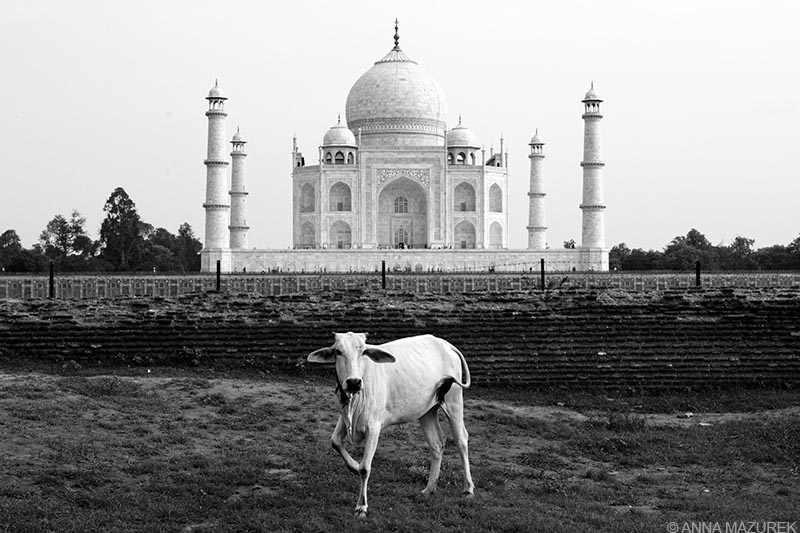
A stray cow stops to pose for a photo at Metab Bagh gardens, which are across the river from the Taj Mahal.
1. Metab Bagh
Metab Bagh is the best place to get an iconic view of the Taj Mahal minus the crowds. These stunning gardens lie across the river from the Taj. From my experience, it’s one of Agra’s best kept secrets because taxi drivers never seem to want to take you here unless you are clear about where you want to go. TIP: Go at sunset then go see the Taj at sunrise the next day. (Trust me on this, I’ve been to the Taj seven times.)
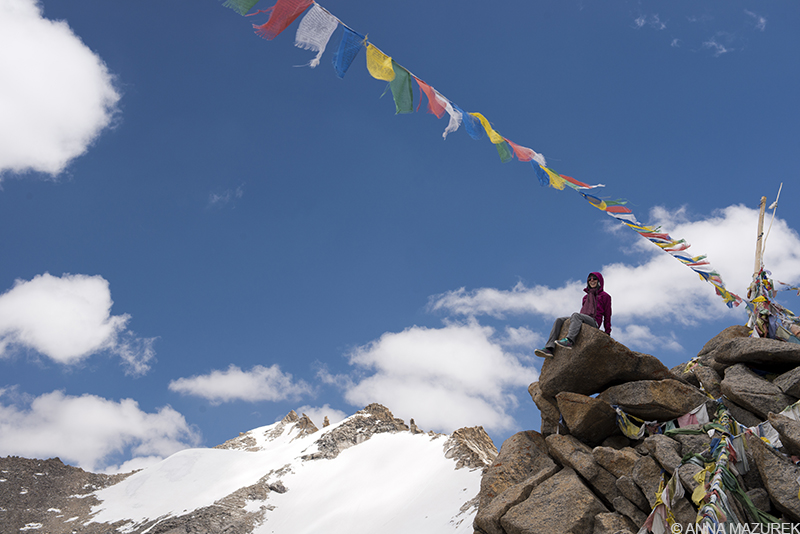
I faced my fear of heights to climb on this rock over the edge of the cliff at Kardung La pass in Ladakh, India.
2. Khardung La
Imagine a spider web of colorful, tattered Buddhist prayer flags strung from a rocky snowcapped mountain top. Include a small tea stand and a giant sign that says you are on the world’s highest motorable road, and you’re at Khardung La. The scenic mountain pass is located in the Ladakh region 39 km from the trekking tourist hub of Leh and connects the Shyok and Nubra Valley. While the sign at the top claims, the altitude is 18, 379 feet, it’s actually 17,582 feet. Until a few months ago, the pass held the title as the highest motorable pass in the world but a new road in India has now claimed the title.
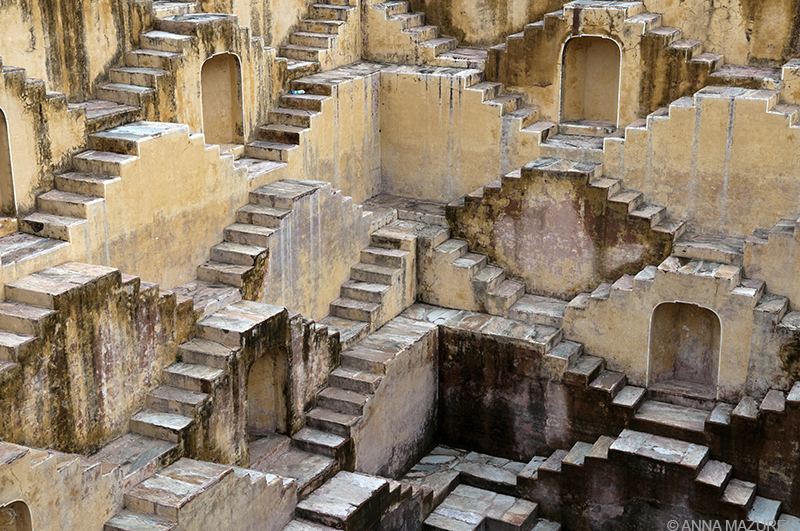
Stepwell, Panna Meena ka Kund, Amber, India
3. Panna Meena ka Kund, Jaipur, Rajasthan
This 16th century stepwell lies near the Amer Fort in Jaipur. It’s smaller than the famous Chand Baori stepwell, and there are no barriers keeping you from climbing the steps to the water. It’s deserted after the crowds leave the Amer Fort.
4. Kerala Backwaters
Everyone should spend a few days or a week living on a houseboat exploring the tropical backwaters of Kerala, a palm-tree lined labyrinth of canals, rivers and lakes that parallel the Arabian Sea in Southern India. The state of Kerala is rated as one of the safest and most environmentally friendly. In my opinion, it’s one of the cleanest parts of India. Southern Indian food is amazing especially thoran, a dry curry with shredded coconut and beets.
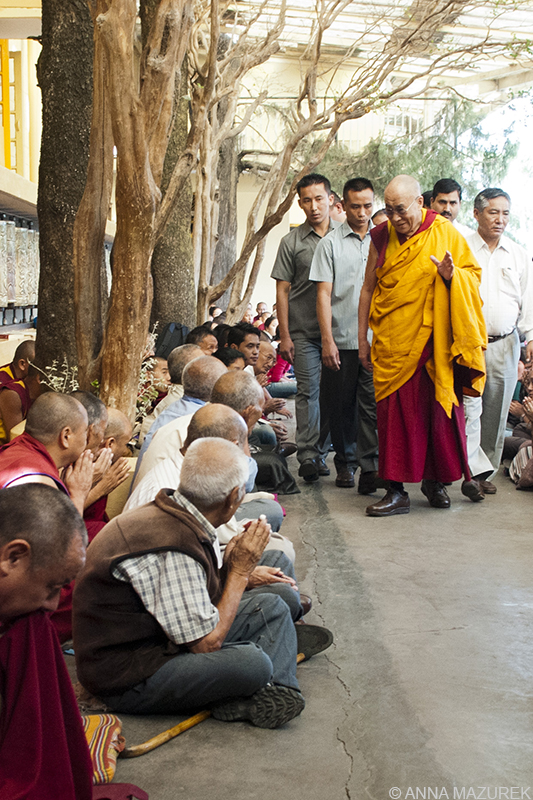
His Holiness the Dalai Lama waves the crowd as before his teaching at his temple in McLeod Ganj, India on June 9, 2012.
5. Dalai Lama’s Teaching in McLeod Ganj
One of the most amazing experiences in my life was attending the Dalai Lama’s teaching at his temple in McLeod Ganj India. I managed to get a photo pass two years in a row. (You can’t take in a camera unless you have a photo pass.) The experience itself is amazing – the power of his humble smile, the smell of the fresh bread the monks pass out while he speaks and the hum of countless languages floating around the room. His temple itself is stunning. Even if you can’t hear him speak, be sure to explore his stunning temple.
How to attend the Dalai Lama’s teaching in McLeod Ganj: You need a ticket, which are only available three days before the teaching at the Tibetan Branch Security Office. Foreigners must bring their passports to register. Seating is first come, first serve with most locals saving their seats a few days before by marking their spot with a pillow. There’s heavy security and metal detectors when you enter so arrive early. For more information, check the Dalai Lama’s website.

The Qutb Minar is one of my favorite spots in Delhi to take my friends and photo students.
6. Qutab Minar
If you love ancient ruins, then you’ll love India. The Qutab Minar is one of my favorite. The UNESCO World Heritage Site lies in Delhi and features a 239-foot tall sandstone tower built in the 13th century. It was a victory tower built after the Islamic conquest of India. Be sure to explore the intricate cloister columns of the Quwwat-ul-Islam mosque at the base of the tower. (Entry fee: Foreigners 500 Rupees/$7.65 USD; Indians 30 Rupees/ 45 cents USD)
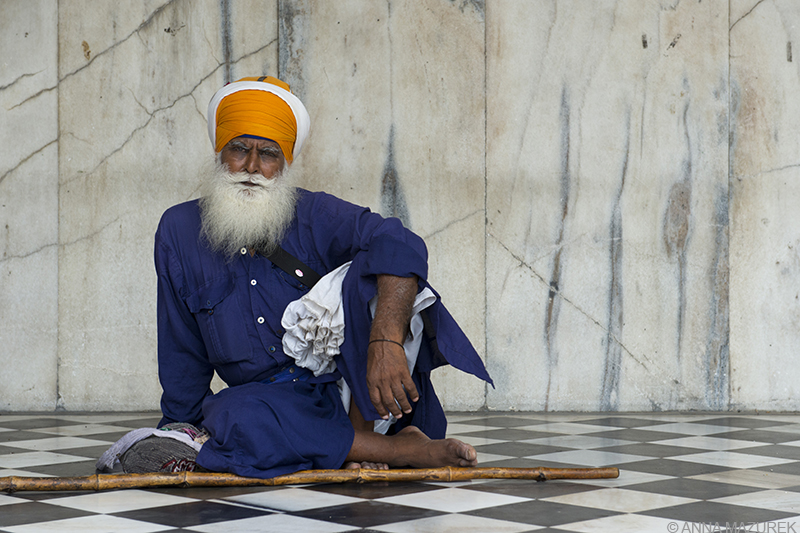
A man rests along the edges of the holy pond at the Gurudwara Bangla Sahib Sikh Temple in Delhi, India.
7. Bangla Sahib Gurudwara (Sikh temple), Delhi
If you only visit one place in Delhi, this is it. Built in 1783, the white-marble Sikh temple complex, topped with golden domes is surreal. It features a Gurudwara (main worship hall), large holy pond and langar (kitchen). The kitchen serves free meals twice a day and is open to everyone. People of all faiths are welcomed to visit the temple and volunteer. Everyone here is so welcoming and kind. I once visited the temple to watch a lunar eclipse, which was an amazing experience. Bring a bandana or scarf to cover the top of your head to visit. No shoes are allowed inside. Entry is free, and there’s a helpful tourist office.
8. The Blue City (Jodhpur)
Jodhpur will be my first stop on my next trip to India. It’s been on my list for years. It’s the largest city in Rajasthan and known for its blue buildings. It’s called the “sun city” because it has sunny weather year-round. The houses are painted blue to keep them cooler. It’s accessible by train from Delhi and Instagram-worthy.
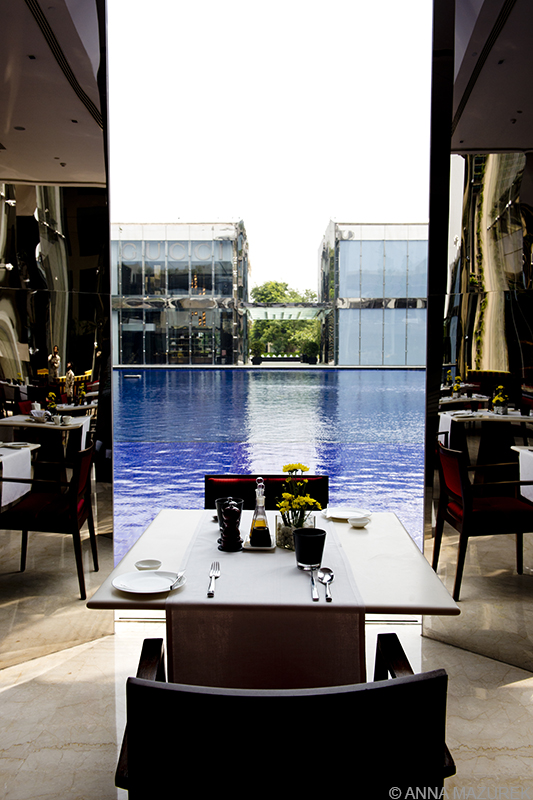
Oberoi Hotel Gurgaon, Delhi, India
9. Breakfast Buffet at the Oberoi Hotel
The Oberoi Hotel breakfast buffet is roughly $20 and worth every penny. After a few months in India, this buffet saved me. I was craving real blueberries and yogurt! There is an elaborate display of both Western and Indian breakfast items. Everything listed on their menus along with fresh juices and a long list of teas is also included in the price. There are two locations in Delhi and both are equally amazing. Breakfast runs from 6:30 a.m. to roughly 10:30 a.m. The third location is undergoing renovation and will open in January 2018. To be clear, I never stayed here because it’s out of my price range. I would just stop by for breakfast as a treat to myself.
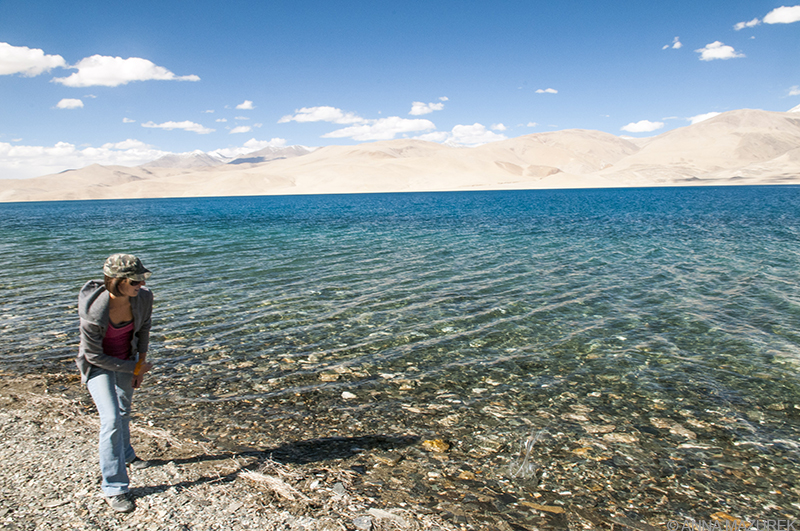
I love skipping rocks at Tso Moriri lake in Korzok, India near the Tibetan border. It’s a six hour drive from Leh roughly.
10. Skip Rocks at Tso Moriri Lake
Tso Moriri Lake is one of the best places to skip rocks in the world. It’s the largest high altitude lake in India at 14,836 feet and lies near the Tibetan border. The water is crystal clear and fed by springs and melting snow. (It’s freezing. I stuck my feet in once.) It’s located near the town of Korzok about a six-hour drive from Leh down bumpy roads. There’s an unlimited supply of flat rocks along the edge of the lake. The locals are total pros at skipping rocks!
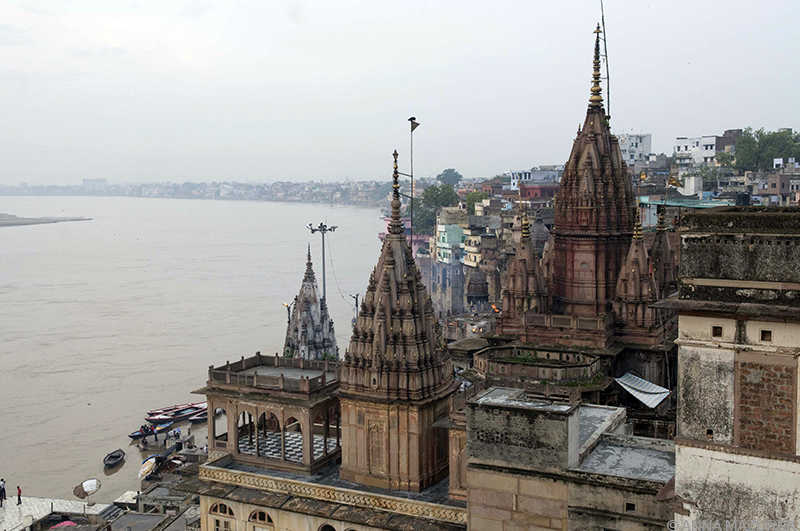
View of the Ganges River in Varanasi, the holiest city in India
11. Varanasi
Varanasi is the epicenter of the charming chaos of India. It is the holiest city in the country – the center of life and death – and possibly the oldest living city in the world. Hindu pilgrims journey to the city to wash away their sins at the bathing ghats along the holy Ganges River. Being cremated at the burning ghats along the river is said to end the cycle of rebirth. Ironically, the sacred river is severely polluted and unsafe for drinking and bathing. Yet, it is normal for a dead cow carcass to be floating within 20 feet of a man bathing. Religion is by far the most powerful force in the world.
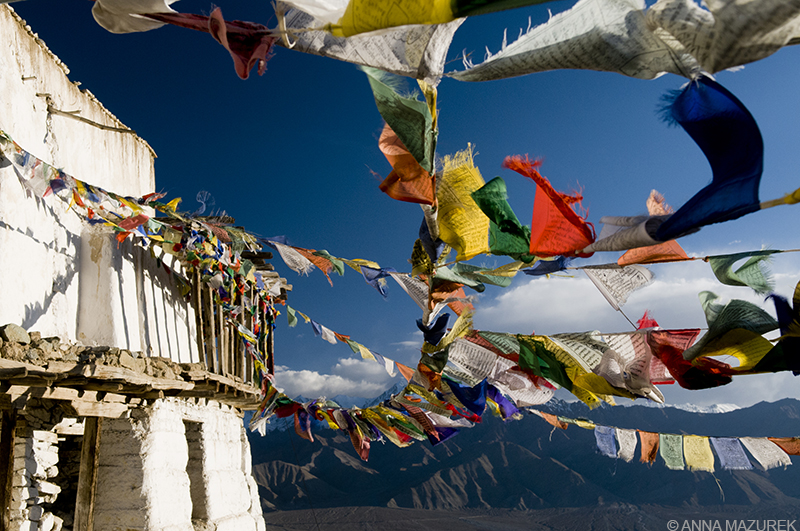
A view of the city of Leh from the Namgyal Tsemo Gompa monastery
12. Leh
Leh is a little tourist town in the Himalayas (11,500 feet) accessible via scary mountain roads or an equally frightening plane landing. It’s a great place for rest between treks and amazing for street photography! It’s by far one of my favorite towns in India. Take the short hike to Leh Palace and Namgyal Tsemo Gompa monastery from town. There’s several great monasteries and palaces nearby including Stok Palace, Shey Palace, Spituk Monastery, Thiksey Monastery, Matho Monasteary, which can be done in a day tour. I recommend visit nearby Alchi and doing homestays in Ang.
______________________________________
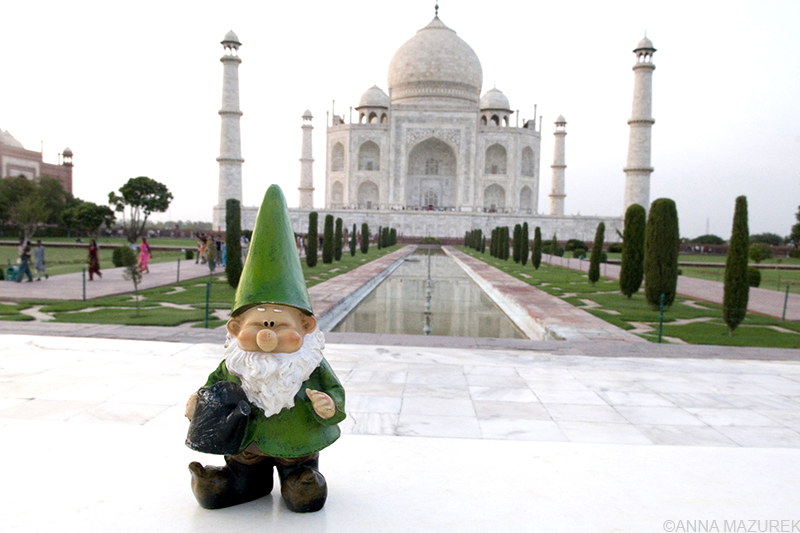
Alfred is probably the only gnome that’s ever been kicked out of the Taj Mahal.
Tips for Visiting the Taj Mahal
- Visit at sunrise. Be there first thing when they open at sunrise. There’s less people, bugs and vendors trying to shove little Taj snow globes in your face. Plus, the light is nice for photos and it’s cooler. The Taj is open sunrise to sunset daily. There’s no exact times listed on their website. They are closed on Fridays.
- Don’t go on Fridays. Again, it’s always closed on Fridays.
- Dress appropriately. Both men and women should cover their knees and shoulders. I recommend wearing those baggy hirim pants, which are cool and great for keeping the mosquitos away.
- Don’t take a bag. Carry your camera. They are very strict about what you take inside. No pens, gum or toys are allowed. It’s a very holy and fragile place. (My gnome got kicked out the second time I took him. Although, there was a professional level British film crew shooting parkour inside but yet my gnome wasn’t allowed.)
- For the best photos, visit Metab Bagh mentioned above. These are the gardens across from the Taj. I recommend to visit at sunset the night before you see the Taj.
- Plan your transport. The trains to Delhi only run at certain times so you pretty much have to spend a night in the city. It’s annoying. I think the trains back to Delhi only leave in afternoon. You can rent a driver to take you from Delhi as well. If you do this, pay the $15 for the toll road. It’s only 3 hours and much nicer than the seven hour insanity you’ll endure on the other route.
- Visit the Red Fort. You get a discount on admission if you do this and Taj on same day.
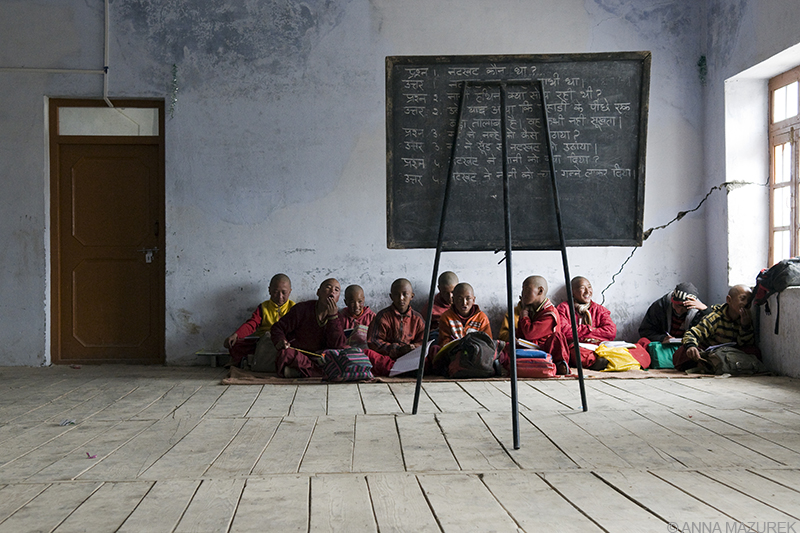
A school for monks in Korzok, India
Other tips for India
- India is a vast country. You can’t see it all at once. Plan according to seasons based on where you want to go. Summer is miserable in Delhi but perfect in Ladakh. Choose accordingly.
- Take safe taxis in Delhi especially at night. MERU is a safe taxi service I recommend in Delhi. They operate from the airport and you can call them anytime. Otherwise, have your accommodation order you a taxi. Tuktuks are fine during the day but be weary at night. The metro trains in Delhi are really nice and have a separate women’s car.
- Dress conservatively out of respect. Cover shoulders and knees at all times.
- Accept the fact that you will get sick. It’s part of the experience. Pack antibiotics and electrolytes.
__________________________________________
COMING UP NEXT
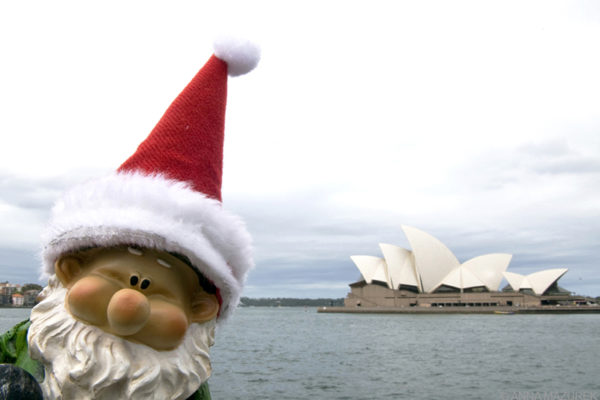
Every year I shoot a different gnome Christmas card. This is my card from 2008 when I lived in Sydney. Check out all of his previous Christmas cards here.
Best Travel Gifts for the Holidays
After an intense year of traveling (Kilimanjaro, Yellowstone, etc.), I’ve discovered a ton of great gear and accessories that have made my life easier. I’ll share my top travel gift ideas for the holidays in my next post, which you can easily send to Santa or pass along to your family.
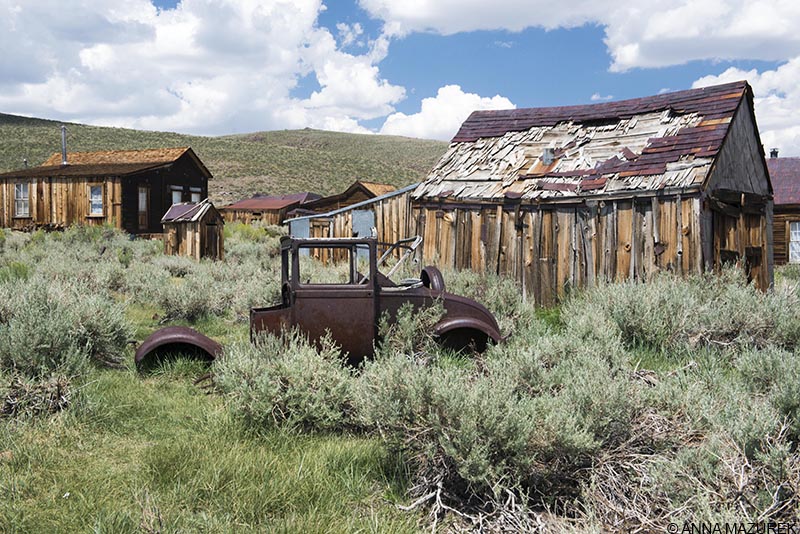
How to Get to Bodie State Historic Park

Gold was found in Bodie, California in 1859 and mining continued until 1942 when the town was abandoned. The town became a California State Park in 1962.
Ghost Town Road Trip: A Guide to Bodie State Historic Park in California
Let me tell you a travel secret: The most amazing places are usually the hardest to find. The ghost town of Bodie State Historic Park in California is one of those places. It’s literally in the middle of nowhere 106 miles south of Lake Tahoe and east of Yosemite National Park.
The former 1800s gold mining town is now a California State Park. It was preserved in a state of “arrested decay,” which means the foundations, windows and roofs were repaired and stabilized but not restored. There’s no mannequins with ill-fitted costumes or bowls of wax grapes in sight. No fake reenactments or ice cream shops. It’s refreshingly beautiful especially for someone like me who is obsessed with photographing abandoned places and ancient ruins. I squeezed in a day trip to Bodie on a trip to Tahoe when I was visiting a friend in San Francisco at the end of the summer.
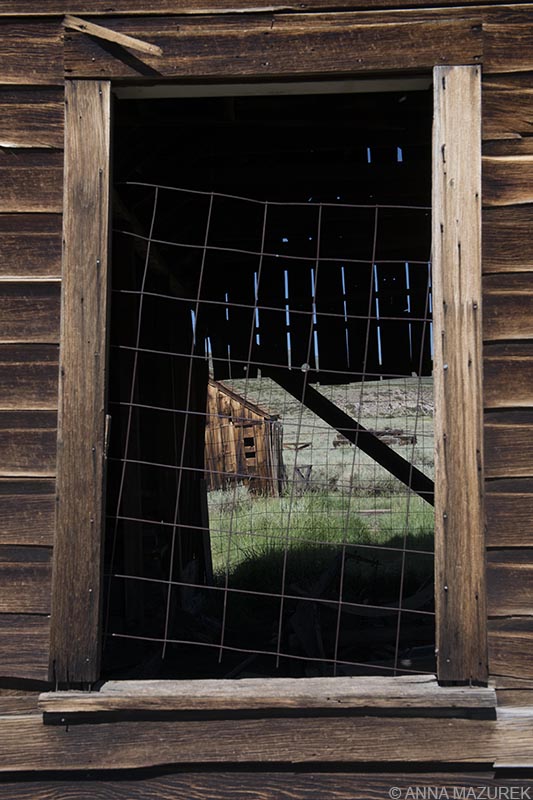
Bodie’s population ranged from 7,000 to 8,000 at its highest point.
Gold was first discovered by W.S. Bodey of New York in 1859. He died in a blizzard a few months later and never saw the town that became his namesake, which oddly enough was spelled differently. The boomtown days of Bodie started after mine collapsed in 1875 to reveal a rich body of gold ore. During the rush, the mining district included 30 different mines and nine stamp mills from 1877-1881. Unsuccessful mines started closing and the population plummeted in the early 1900s. Mining ceased in 1942. Caretakers were hired by the family of James S. Cain, Bodie’s last major landowner, to protect the town from vandals and looters. California State Parks purchased the town in 1962 to preserve the town and buildings.
Prepare to spend most of the day in Bodie. Over 50 buildings are still standing and a handful are open to the public including the 1890 Standard Mill, which is accessible only by guided tour three times a day. The town covers a large area and might feel like a bit of a workout since the town is at an altitude of 8,375 feet.
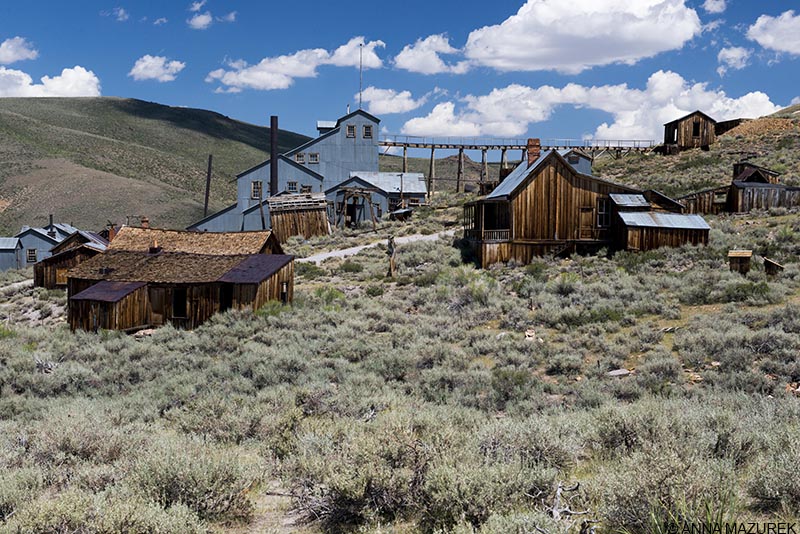
The Standard Consolidated Mining Company’s Stamp Mill was the most successful of the 30 mining companies in Bodie. It yielded $18 million over the course of 38 years. The mill is open for guided tours daily.
Tours
Once you pay the entrance fee, you are free to roam the town accept the Stamp Mill and other areas that are fenced off for safety reasons (old mine shafts). The only way to see the inside of the Stamp Mill is on a 50-minute tour, which are offered daily for $6. Tours are offered at 11 a.m., 1 p.m. and 3 p.m. from June to early September. If you’re visiting outside of that date range, ask the park museum for tour times. (I highly recommend the tour for photo opportunities.)
During the summer months, the park offers night Ghost Walks and Ghost Mill Tours featuring legends and ghost stories about the town. There are usually three different tour dates that sell out quickly.
Be sure to bring water and snacks. They do have water fountains by the restrooms, but they don’t always work.
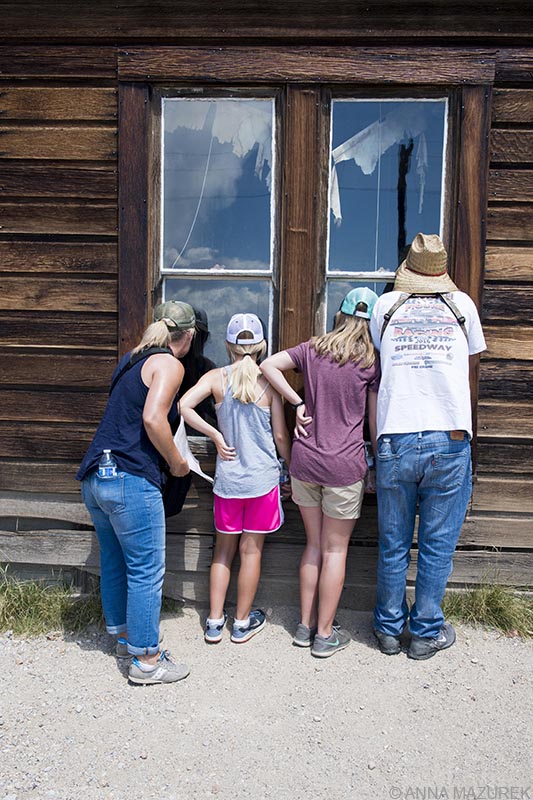
Bodie is crowded in the summer months so arrive early for the best parking and photos!
When to Go
Due to the altitude (8,375 feet), it can be difficult to reach Bodie in the winter except by skis, snowmobile and snowshoes. The park is open all year.
Summer Hours (March 18th – October 31st): 9 a.m. – 6 p.m.
Winter Hours (November 1st – March 17th): 9 a.m. – 4 p.m.
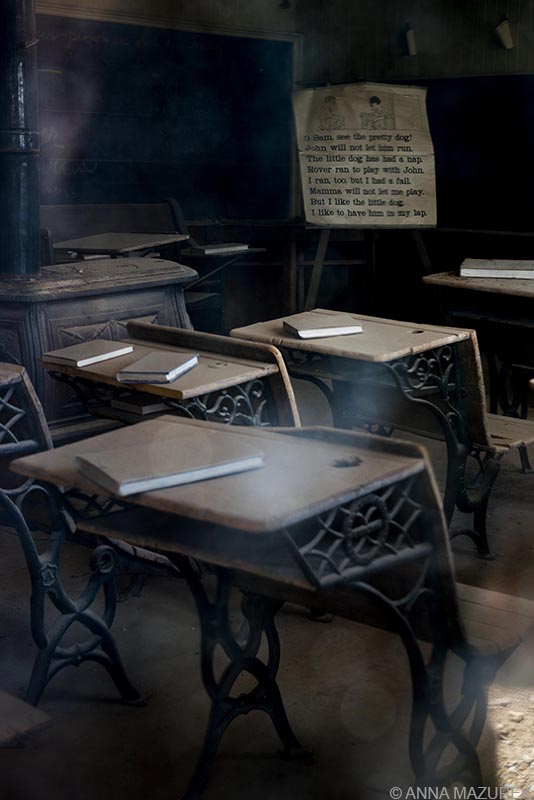
The Bon Ton Lodging House became the second schoolhouse in Bodie after the first one burned down. It closed in 1942 and had its highest enrollment of 615 from 1879-1880. This image was shot through a window, which created the semi-blurry effect.
Entry fee
Adults: $8
Children (age 3-17): $5
Children under age three: Free
Be sure to buy the $2 map and guide because the buildings aren’t labeled.
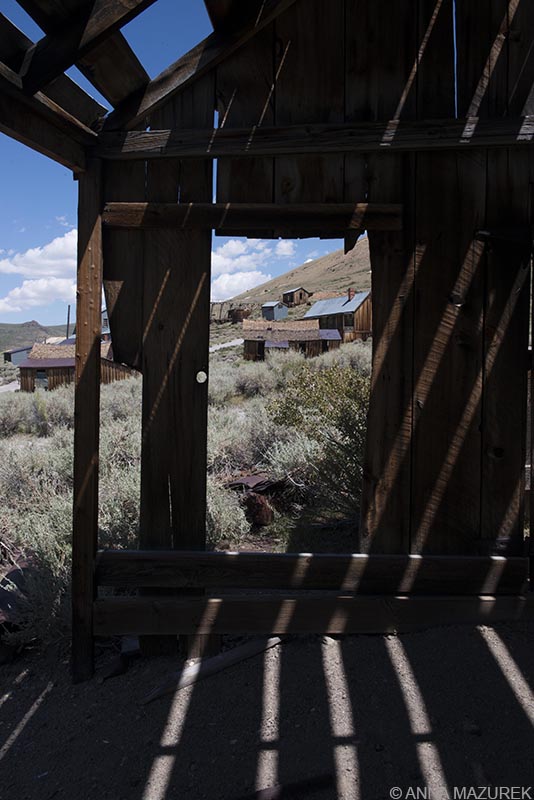
There were more than 60 saloons in the Bodie and opium dens in the Chinatown section.
How to get to Bodie State Historic Park
While the town is 106 miles southeast of Lake Tahoe, the drive takes two hours due to the tiny two-lane roads and construction at times. Cell service is spotty. Be sure to arrive early as the parking lot fills quickly. The park is 13 miles down a bumpy, dusty road from Highway 395. For more information on Bodie, visit the park website.
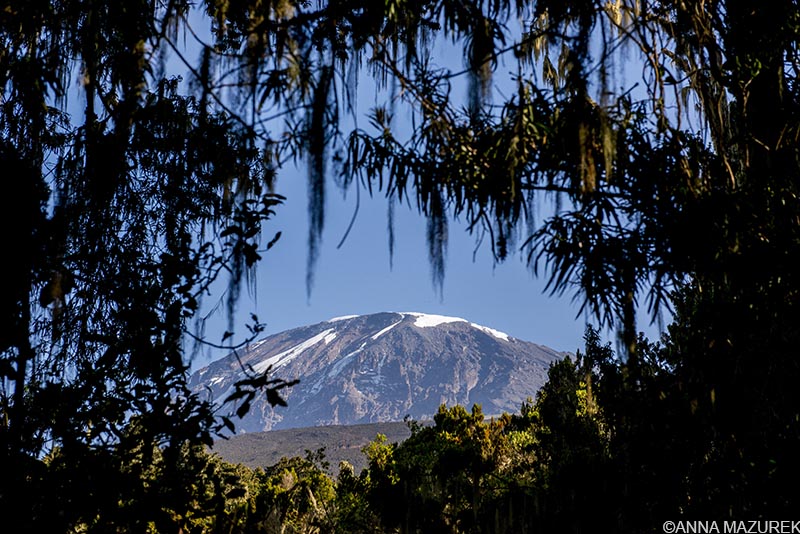
Kilimanjaro 101: Cost, Routes & Packing List

Our last view of Kilimanjaro through the rainforest on the trail to the Mweka Gate on the last day of our trek.
Two weeks ago, I hiked the Lemosho Route to the summit of Kilimanjaro. I’ve compiled all the main questions about the trek including when to go, which route to choose, what to pack and a breakdown of the costs. In my previous post, I provided a day-by-day breakdown of what it’s like to climb Kilimanjaro along with photos.
Best Time to Climb Kilimanjaro
Overall, there are two main trekking seasons: January to March, which is usually colder and quieter, and June to October, which is usually the busiest because of holiday travel in Europe and North America. Snow fall is highest from November to May. December is becoming popular due to holiday season, but it’s very cold. March to May is the rainy season, and the worst time to climb. November is also rainy.
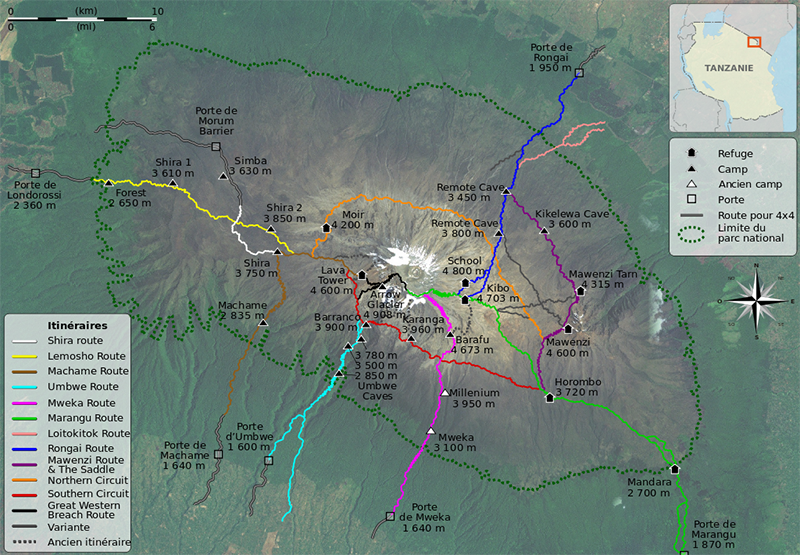
Kilimanjaro Route Map courtesy of WikiMedia Commons
Which Route is Best to Climb Kilimanjaro?
I sat down with my guide and interviewed him one night about hiking the mountain. Here’s everything you need to know from a guide who’s hiked the mountain 150 times.
All of our guides preferred the Lemosho and Macheme routes the best because they have the best weather and scenic views. He says the easiest summit routes are Shira, Lemosho, Macheme and Umbwe, which all summit the same route. Many routes offer an option to add a day to help acclimatize.
The Seven Main Routes to Climb Kilimanjaro
1. Lemosho Route (6-7 days)
Along with Macheme, this has the highest success rate because it’s longer and offers the best opportunity to acclimatize. The hike out of the park on the last day is very easy (3 hours) compared to Macheme.
2. Macheme Route (5-7 days)
Macheme is very similar to Lemosho except the first and last days are longer. It offers the same amount of acclimatization. The last day is a full day of hiking.
3. Shira Route (6-7 days)
This route is easier because you drive directly to Shira I camp and start from there, which personally I think is cheating a bit. The hike to Shira I is steep but nothing compared to summit day.
4. Ubwe Route (5-7 days)
This is the hardest route because it’s very steep especially the first two days. It offers a very picturesque view of Baranco camp, which is why people choose it.
5. Marangu Route (5-6 days)
This route has huts instead of camping. There are bathrooms but no showers. The sinks have cold water, and they give you warm water to wash your face. You can acclimatize well on the six-day route. The weather isn’t the best, and the summit route is more difficult. The route to Keebo Hut is also very dusty. This route is just for people who don’t wan’t to camp.
6. Rongiai Route (5-7 days)
This route is the easiest and is located by the Kenya border. It’s dangerous because of the potential of animals (lion, elephant, water buffalo). It follows the same summit route as Maraugu. It’s only a 2-3 hour walk each day and the hardest day is summit day.
7. Mweka Route – Down Route Only
This route is a down-only route. It starts at Barfu High Camp and has two camps – Mweka Hut Camp and High Camp (Millennium Camp on some maps).
Other options: The Northern Circuit Route is the newest and longest route. It follows the Lemosho Route initially then circles around the quieter northern side of the mountain.
The Western Breech is the most dangerous route and should be avoided. Most high-profile tour operators won’t even offer this route. It runs by Arrow Glacier. The route is steep and there’s a high risk of rock fall. Three people were killed by rocks here in 2006. The Tanzanian government requires you sign a waiver just to climb this specific route. All the guides hate it.
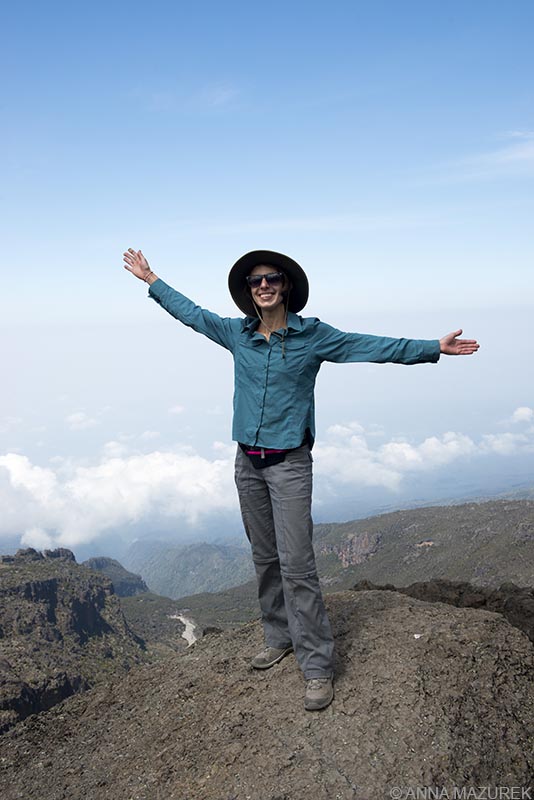
I’m totally rocking my wide brimmed hat, amazing SPF/wicking shirt, Prana pants, Keen hiking boots and the SPIbelt waist belt for my phone at the top of Baranco Wall on day four of the trek.
Kilimanjaro Packing List*
Clothing
- 2 pairs of long sleeve thermal tops (I prefer these zip-neck thermals the best.)
- 2 thermal pants (merino wool or Capilene)
- 1-2 short sleeve shirts OR 1 long-sleeve wicking SPF shirt
- Heavy fleece or down jacket
- Fleece pants
- 2 pairs of trekking pants (These Prana pants are the best.)
- Waterproof jacket/raincoat
- Waterproof pants (Consider getting insulated waterproof pants.)
- Underwear (one for every day of the trek)
Hat & Gloves
- Wide brimmed hat
- Wool hat that covers ears
- Ski mask or balaclava
- Lightweight gloves
- Wool or down mittens to layer over gloves (This pair was the cheapest I could find.)
Footwear
- Hiking books that cover ankle (I loved my Keen Terradoras.)
- Camp shoes (I took my old Nikes.)
- Shoe bag to carry spare shoes
- Hiking Socks (7 pairs)
- Gaiters (These were the most helpful on summit day.)
Sleeping Bag
Most tours provide sleeping bags, but I recommend bringing another to double layer because it gets really cold. I wore almost all my layers every night to sleep. Don’t forget to bring a travel pillow!
On the Trail
- 20- to 30-liter daypack for carrying what you need on the trail (I recommend Osprey Packs for their lifetime warranty.)
- Rain cover for daypack
- 1.5 to 2 liter CamelBak (This will freeze on summit day but amazing the rest of the time.)
- CamelBak bite valve cover (Trust me, it’s worth the extra money.)
- 2 – Nalgene bottles (32 ounces)
- Sunglasses
- Headlamp with extra batteries
- Trekking Poles (rent these in Moshi)
- Snacks
Other items:
- Waist belt for phone (This SPIbelt was the best thing I took on the trip! I always had my phone handy without having to dig it out of daypack.)
- Hand & Foot Warmers
- Electrolytes (These Nuun tablets are the best! Taste great and only 1g sugar! Lemon Lime flavor is my favorite.)
- Moleskin and Band-Aids for blisters
- Journal and pen
- Extra batteries and phone charger
- Packing cubes
- Ibuprofen
- Antibiotics for diarrhea and altitude sickness (Talk to a doctor before your trip.)
- Wet wipes & hand sanitizer
- Basic toiletries
- Hand towel
- Protein powder
- Passport and money (Keep it with you at all times!)
- Dry bags and laundry bag to put dirty clothes
- Sunscreen (I recommend a natural stick SPF like Bare Republic.)
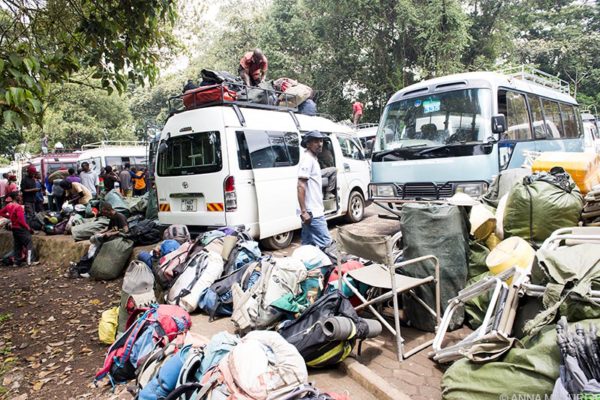
Packing Tips for Kilimanjaro
- The more things you can access without taking off your daypack, the easier the trek will be. That’s why finally investing in a 1.5-liter CamelBak was the best decision I made. I recommend the bite value cover to keep the value clean. I had two 32-ounze Nalgene bottles for summit day since I knew the CamelBak would freeze.
- I managed not to get sunburned thanks to the ridiculous large brimmed hat that I bought and the Columbia Silver Ridge Lite wicking/SPF I wore that shirt everyday almost.
- I recommend using packing cubes to organize your bag. Trekking companies provide a waterproof duffel bag for your things. It makes life so much easier if you have packing cubes organized socks, another for top layers and another for meds, etc. so it’s easy to find things.
- I bought vanilla flavored hemp protein powder to help give me energy on the long days and especially on summit day. It was a huge help.
- Every afternoon, I dissolved the Nuun electrolyte tablets in water to help rehydrate. They were a total lifesaver. One to two tubes were sufficient for trek. There’s 10 tablets in each tube and lemon lime is the best flavor.
- Talk to a doctor about possibly taking antibiotics with you on the trip to help with altitude, nausea and diarrhea. (I got food poisoning 12 hours before my flight home and antibiotics saved me. I also took Diamox for altitude. I took a very, very low dose since I had a bad reaction in India the one year I took it.)
- For easy access to your phone for photos, consider this SPIbelt for your waist. I borrowed one from a friend and it saved me.
- Most tours provide sleeping bags but consider bringing your own if you have one to double layer. It was REALLY cold and I slept in all of my layers most nights.
- Make sure all your thermals are either merino wool or Patagonia’s synthetic Capilene. Your socks should all be merino wool. I just bought whatever socks REI had on clearance regardless of the color.
- Take a trash bag or shoe bag to pack your hiking boots after the trip. You’ll want a shoe bag for your camp shoes during the trek as well. Your shoes will be GROSS especially after the bathrooms.
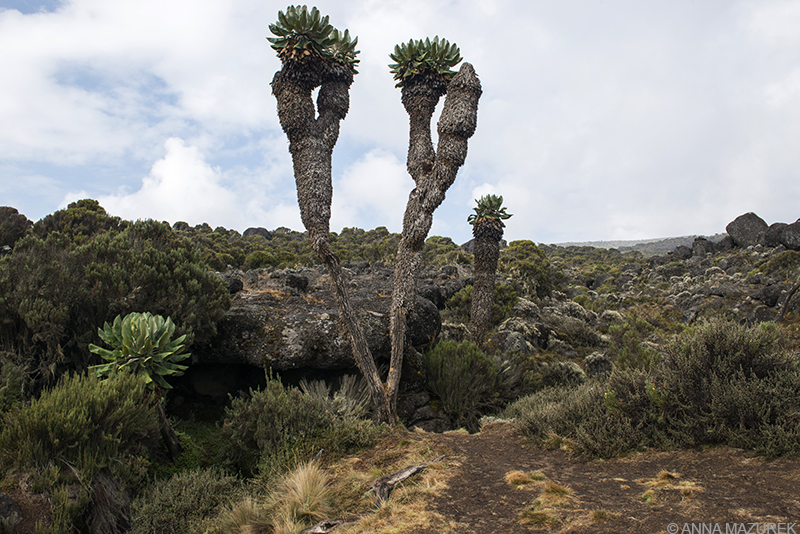
The route to Baranco Camp is covered with these stunning cactus-like trees known as giant groundsel.
How Much Does It Cost to Climb Kilimanjaro?
Trek: $1,850
Tips: $300
Flight: $1,150
Visa: $100
Gear: $284.12
Total Cost of Climbing Kilimanjaro: $3,584.12 USD
- Trek Cost: Most routes start at $1,600 and range to around $2,000. All treks include transport into the park, guides, porters and cooks. You can’t hike the mountain without a guide. Accommodation the night before and after are usually included as well as airport transfers. We paid $1,850 for our Lemosho Route, which is normally advertised for around $2,100. We got a discount because of the number of people in our group and the fact that my friend had used the same company in Nepal.
- TIPS: We were advised to bring $250 to tip our guides, porters and staff. I tipped the porters who carried my camera and the gnome individually a bit extra. I arrange this in advance.
- VISA: It cost a $100 for a Tanzania visa for me because I’m American. Most countries are $50.
- Flight Cost: My flight was $1,150 roundtrip from Houston to Kilimanjaro on Turkish Airlines with a stop in Istanbul. It was the most direct route I could find from Texas that didn’t involve more than one stop. Plus, Turkish Airlines is really nice.
- Gear: I had a lot of gear and borrowed what I could. I bought two pairs of thermals, lots of socks, electrolytes, CamelBak, a wide brimmed hat and a Columbia long sleeve SPF wicking shirt. I took advantage of the back-to-school tax-free holidays and Labor Day sales so I got a great deal. The gear in Moshi is horrible quality so buy things before you leave. The only exception is trekking poles or gaiters.
For more about climbing Kilimanjaro, check out my previous post that provides a day-by-day breakdown of the Lemosho Trek!
____________________________________________________
*P.S. I am not sponsored by any of the brands or products mentioned above. I have used all the products myself and found them extremely helpful. Please note some Amazon affiliate links are included above. If you click on a link and make any type of Amazon purchase, I earn a small commission with no additional cost to you. I hope you found this post helpful and appreciate your support of the blog. Please email me if you have questions.
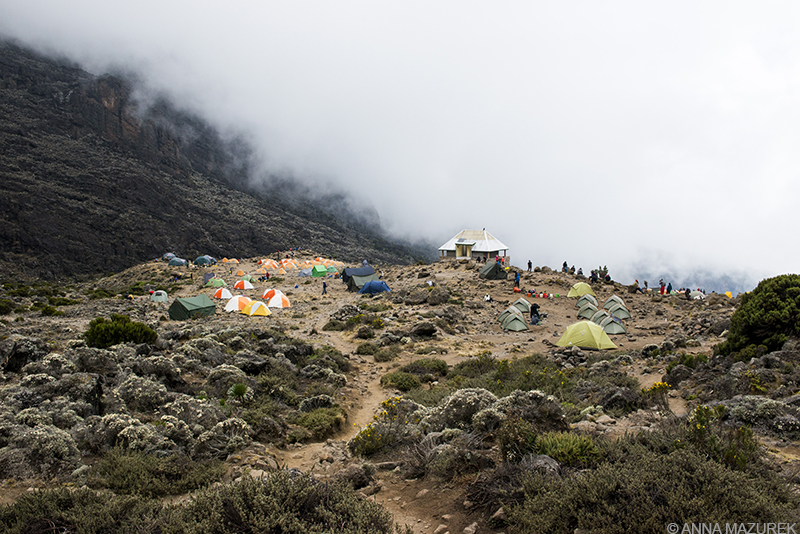
What It’s Like to Climb Kilimanjaro
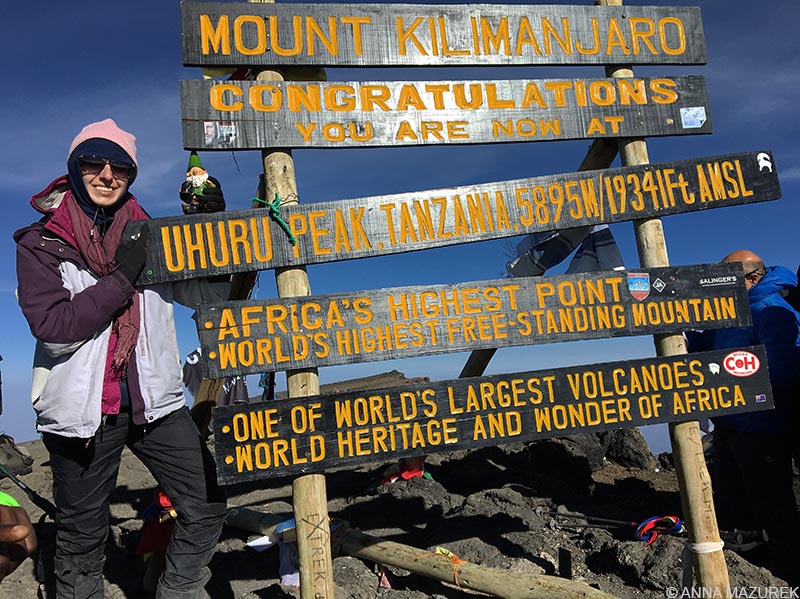
Alfred the Gnome and I made it to the top of Kilimanjaro. Alfred hopes he was the first gnome to the summit.
A Day-by-Day Guide to the Lemosho Route on Kilimanjaro
We are insane.
Those were my initial thoughts when I saw the mountain for the first time. I was in the back of a bus riding down a bumpy road toward the Lemosho Gate to start the trek. Kilimanjaro was looming in the distance over a barren field filled with flat topped trees. The greatest adventure of my life was about to begin.
We are insane.
This would be a reoccurring thought over the next seven days as we attempted to summit Africa’s highest peak and the tallest free standing mountain in the world at 19,341 feet (5,895 meters).
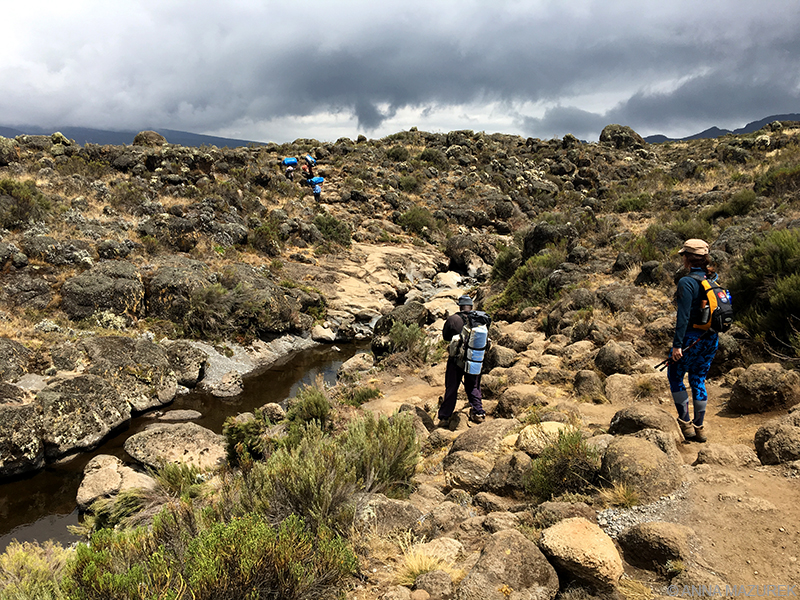
Walking through the moorlands en route to Shira II Camp
Why Kilimanjaro?
I found an old bucket list in my phone from 2014. Kilimanjaro was on the list and had been for years. When I was running photo trips in the Himalayas in India, a few of my co-workers had worked in Tanzania and climbed the mountain. After unsuccessfully trying to work in Tanzania and getting assigned other parts of the world, I put Kilimanjaro aside for a while. A WhatsApp message in June changed everything. One of my best friends half-jokingly invited me to climb Kilimanjaro with her in September. The idea was insane with my current work schedule. I asked the cost assuming it would be absurd. But, it really wasn’t as bad as I thought: roughly $3,250 USD ($1,850 plus $250 tips for the trek itself and a $1,150 roundtrip flight out of Houston). I thought the entire trip would be around $5,000 USD! I rearranged my life and made it work.
I’m 36 and not getting any younger. Plus, I am probably in the best shape of my life. When I was working in India, I spent a lot of time at high altitude both camping at 15,000 feet (the same height as basecamp for Kilimanjaro) and driving up to 18,500 feet to take photos without any major issues. Kilimanjaro is the highest mountain you can climb without the aid of mountaineering gear. It’s just plain uphill hiking; there’s no ice picks, ropes or crampons. All I had to do was walk slowly for six days.
Still, it was the hardest, coldest and most amazing thing I’ve ever done. While exact statistics are hard to find, approximately 30,000 people attempt to climb every year and 75% reach the top. Altitude-related issues are the biggest challenge preventing people from summiting.
I’ve complied a day-by-day breakdown of our trek on the Lemosho route below. For a breakdown of all routes, best times to go and packing lists, check out my Kilimanjaro 101 post. Please note all elevations are from the park signs and hiking times are based on my experience.
Day 1 – Lemosho Gate to Mkubwa Camp
Altitude: 2650 m/8,694 ft; Distance: 7 km/4 mi; Time: 3 – 4 hours
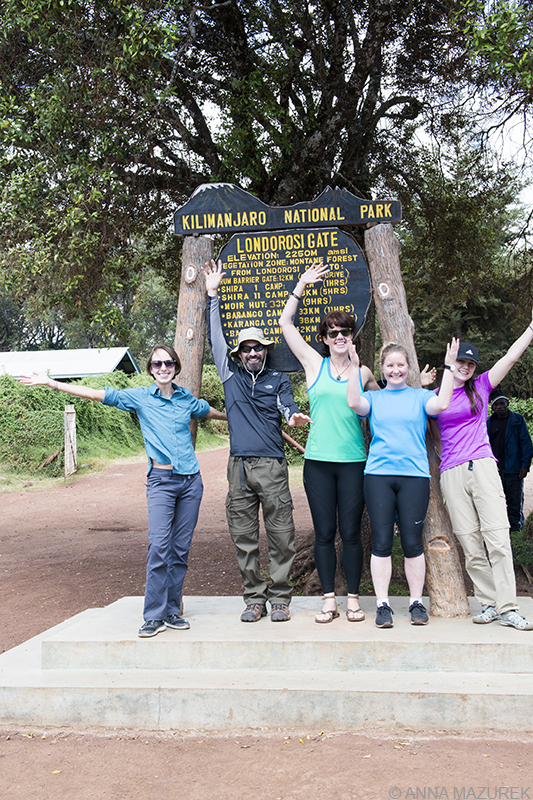
Our first group photo at the gate before we started our trek!
Our first day was very easy. We left Moshi at 9:30 a.m. to finish gathering supplies for the trek and drove over to the Lemosho Gate. We had to sign in and all the porters’ loads had to be weighed since they are only allowed to carry 20 kg/44 lb.
We hiked through the rainforest for a few hours with several monkey sightings including the blue monkey and colobus monkey that has a fluffy black tail with a white stripe that looks like a skunk. We reached out first camp known as Big Tree Camp or Mkubwa before sunset.
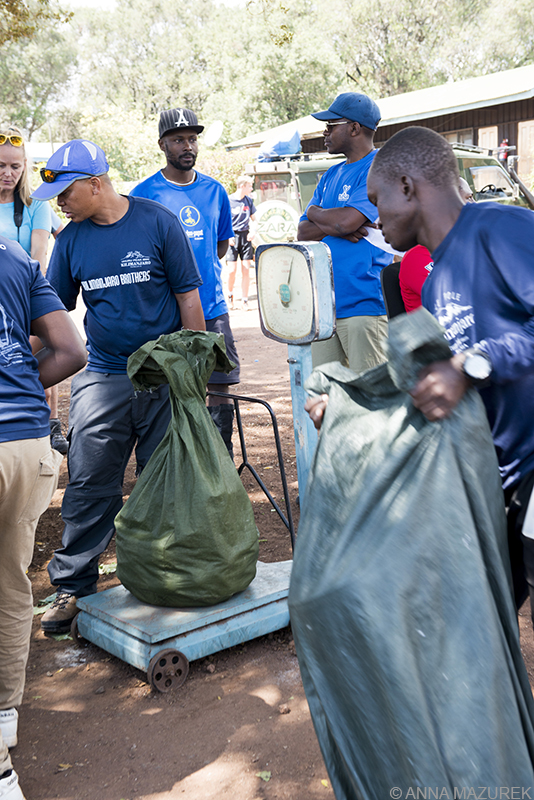
We had to wait at the main gate for the group of ahead of us to weigh all their bags that the porters were carrying. Each porter is supposed to only carry 20 kg/44 lb.
We choose a camping route. All campsites had toilet buildings of some sort, which were normally just squat-style pit toilets. There were no showers during the entire trek. We got hot water to wash our faces and hands every morning and night except at base camp. I wasn’t expecting it to be cold the first night, but it was pretty chilly.
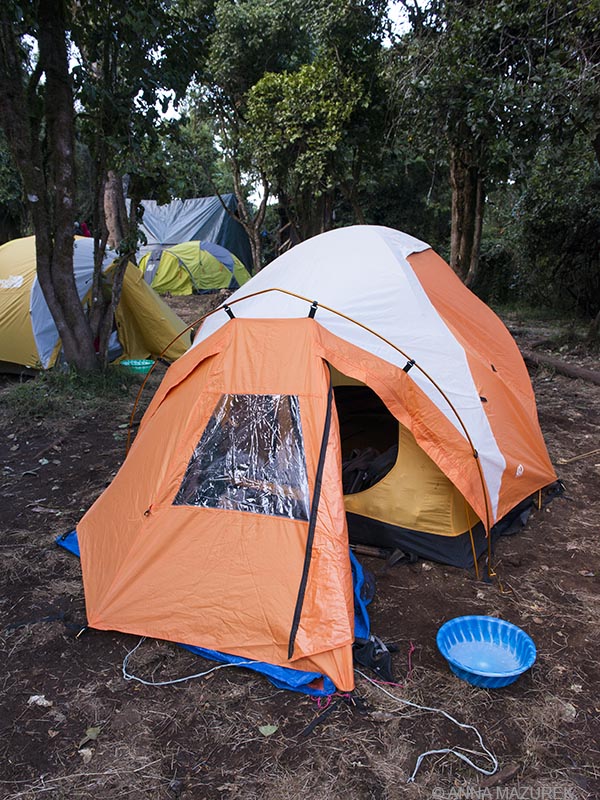
This orange tent was my home for seven days on the trek.
There were five people in our group total including my best friend Becky, a Cincinnati-native living in Tokyo, who organized the whole trek. Two Kiwi girls joined us – Nicci, a diplomat and a friend of Becky’s from Japan, and Polly, a data privacy lawyer based in London who is friends with Nicci. The fifth person in our group was a Canadian accountant named Francois from New Brunswick who decided the best way to celebrate his milestone 40th birthday would be to climb Kilimanjaro, which I think is pretty awesome!
Day 2 – Mkuwbwa Camp to Shira II Camp
Altitude: 3,850 m/12,631 ft; Distance: 17 km/10.5 mi; Time: 6-8 hours
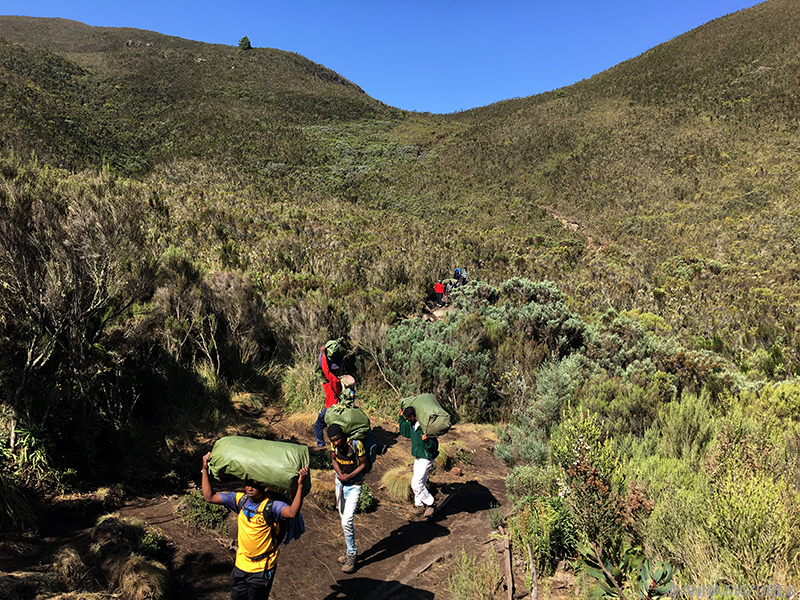
Porter’s carry bags through the moorlands to Shira II camp.
It was a four-hour uphill hike to Shira I from our campsite. The rainforest transitioned into the moorlands with short scrubby trees about my height, which made the last two hours of the hike pretty grueling without the shade from the rainforest trees. I was carrying three liters of water in my backpack, rain gear and not much else. I’d already arranged for one of the assistant guides to carry my camera bag. (My camera body and wide-angle lens weigh about seven pounds and always kills my shoulders during long hikes.)
The main theme of hiking Kilimanjaro is “pole, pole,” which is Swahili for “slowly, slowly.” I learned this lesson a few years ago in Peru when I hiked the Colca Canyon, the second deepest canyon in the world.
I was grateful for the silly wide brimmed hat and the long-sleeve Columbia SPF/wicking button-down shirt I’d reluctantly bought at REI before I left. While I looked silly, they really kept me cool and saved my skin from the sun. You’ll see both in many photos.
After we reached Shira I, we had lunch. It was another few hours to Shira II, which were fairly easy compared to the trek to Shira I. Our guides planned long days in the beginning and shorter trekking days before the summit to help us acclimate and rest.
Day 3 – Shira II Camp to Baranco Camp (via Lava Tower)
Altitude: 3,900 m/ 12,785 ft; Distance: 10 km/ 6.21 mi; Time: 6 hours via Lava Tower

Barranco camp was one of the nicest and most photogenic camps on the trek. The building in the center is the toilets.
We hiked four hours from Shira II to Lava Tower, our highest point thus far (4,600 meters/15,091 feet) to help acclimate. It was a much better hike than the day before. We had lunch there before descending to a lower altitude at Baranco camp, two hours away. It’s one of the biggest and most scenic camps because four routes (Lemosho, Machame, Umbwe and Shira) all stay in Baranco. Since this is an acclimatization day, some people can be affected by the altitude. No one on our group had any issues. Our guide had an oxygen meter. All of our readings were in the high 80s to 90s.
The trek from Lava Tower to Baranco was beautiful! It was filled with stunning cactus-like trees known as giant groundsel (Dendrosenecio kilimanjari) and even a tiny waterfall. We arrived at camp around 3 p.m., which is a few hours earlier than the two previous days when we arrived at 5 p.m. Sunset is around 6 p.m. It’s crazy to think we are only 200 miles south of the equator!
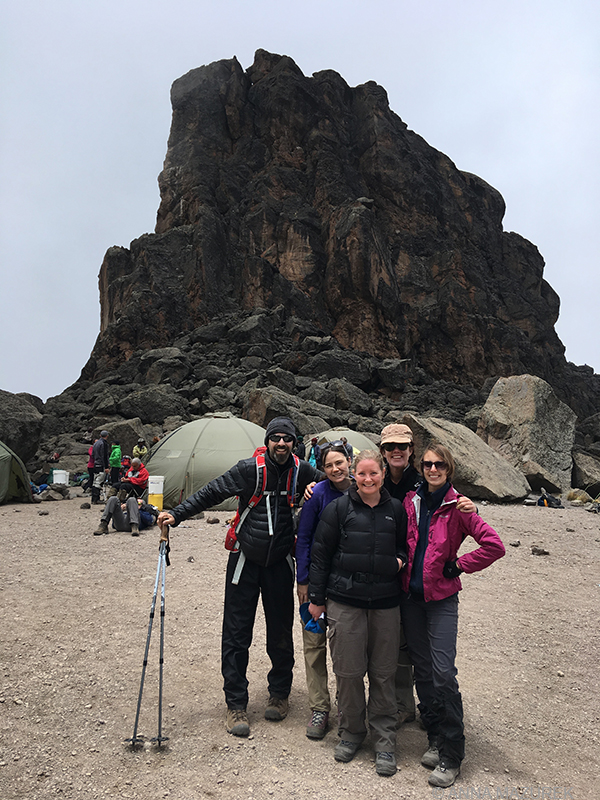
All five of us made it to Lava Tower with no altitude sickness issues!
I haven’t slept well the entire trip due to jet lag. I’ve never had jet lag as bad as I have this trip. I regret not flying in two days early to adjust a bit better. The jet lag combined with the altitude meant that most of us were only sleeping from 9 p.m. to 1 a.m. and just laying there in the cold wide awake. Due to all the water we drank and the Diamox (altitude medicine), we kept having to pee in the middle of the night. I started drinking a lot of water in the late afternoon and not drinking any at dinner to avoid midnight bathroom runs. I drank electrolyte mixes every afternoon as well to rehydrate.
Day 4 – Baranco Camp to Karanga Camp
Altitude: 3,995 m/ 13,106 ft; Distance: 6km/ 3.7 mi; Time: 4 hours
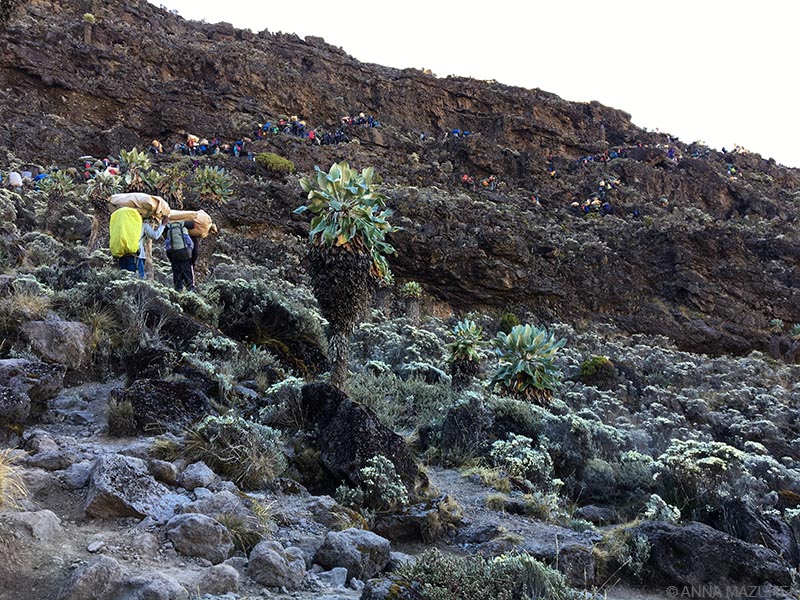
The line of trekkers and porters climbing Baranco Wall was insane. Due to the crowds, it took a good while to get to the top.
Our first task was to climb the Baranco Wall, which looms ominously overhead but actually requires no technical climbing skills. It involves climbing over a few rocks but mostly waiting in line behind the other climbers and porters. We paused at the top of the wall (4,200 meters/13,779 feet) for photos before descending to Karanga Camp. The camp is smaller than the previous and all the toilets are outhouse style. It’s super foggy and almost difficult to find the tent on the way back from the bathroom. Karanga is also the last water point before base camp. The porters have to collect water from here to bring to base camp for us.
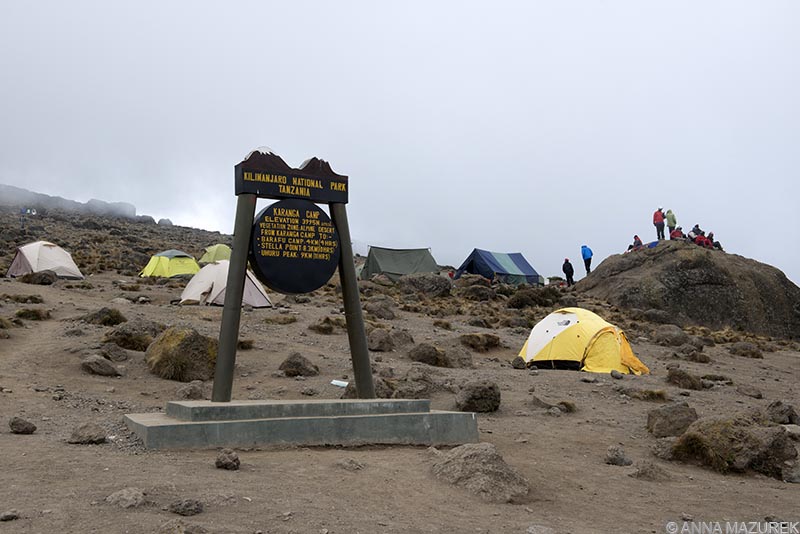
Guides and porters gather on the highest point of the camp on the right to get cell reception. All camps have cell reception.
At every campsite, there’s always a group of porters and guides standing on rocks on one of the highest points. Turns out, there’s cell phone reception at every camp at high points. I choose to stay unplugged during the whole trip and wasn’t even sure if my phone would work anyways.
Day 5 – Karanga Camp to Barfu High Camp
Altitude: 4,673 m/15,331 ft; Distance: 4km/2.4 mi; Time: 4 hours
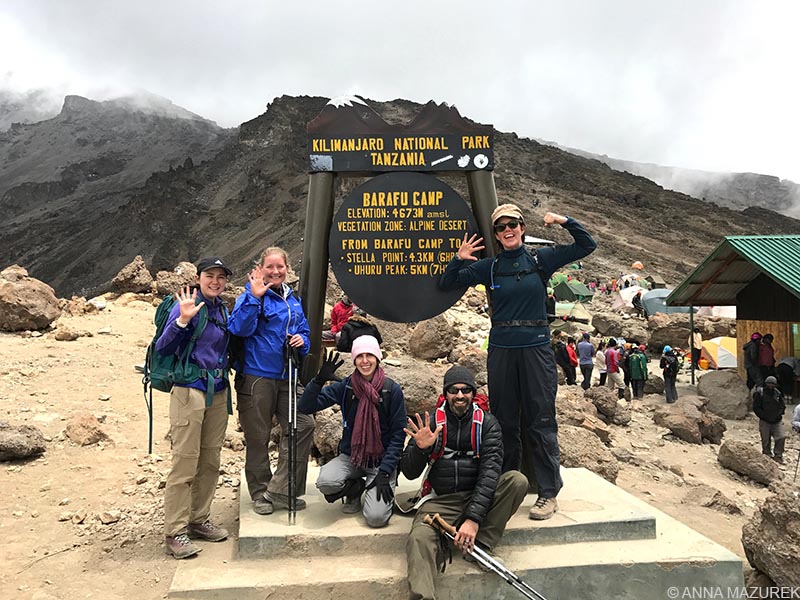
Celebrating day five of our trek with an early arrival to our basecamp – Barafu Camp!
We had a short hike to Barfu this morning and arrived around lunchtime. We had to wait a few minutes for people returning from the summit to pack up their camps so we could set up ours. We had lunch then napped for a couple hours from 2 p.m. to 5 p.m. when we had dinner. Then, our guide gave us our plan for the night. We would sleep until 11 p.m. then get ready to leave for the summit by midnight. I slept well before dinner but due to nerves and the cold, I barely slept at all before the summit. It was freezing and the wind was pummeling our tent nonstop.
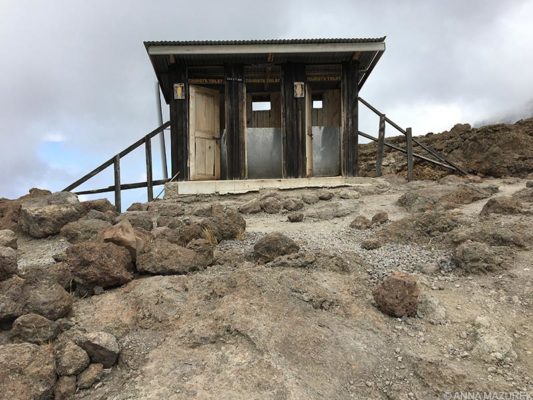
The bathrooms at Barafu High Camp
The photo above is for those of you that wondered about the bathrooms. They were all better than most of the bathrooms in the mountains in India.
Day 6 – Barfu High Camp to Uhuru Point (the summit)
Altitude: 5,895 m/19,341 ft; Distance: 5km/3.1 mi, Time: 7 hours
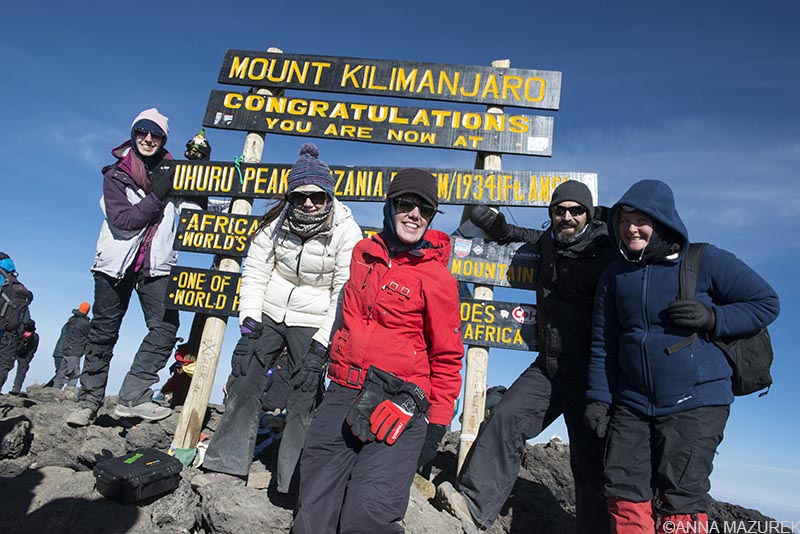
The entire group and the gnome made it to the top! Getting a photo was tricky due to the massive crowd around the sign!
Our alarm went off at 10:30 p.m. for us to get ready. My nerves had prevented me from sleeping. I put on five layers of pants – two Patagonia mid-weight thermals, my Prana hiking pants, a pair of old fleece sweatpants from Target and a pair of $20 rain pants I bought last summer for my Iceland trip. I could barely move in all the layers. My top layers consisted of two long sleeve thermals (one lightweight crew neck and a mid-weight zip neck), a Columbia fleece I’d stolen from my nephew who’d grown it, a Marmot raincoat and an old fleece-lined LL Bean winter jacket I’ve had since grad school. I wore two pairs of merino wool hiking socks, a pair of gloves with a pair of wool mittens on top of them and a balaclava layered under a wool hat along with both my raincoat and winter jacket hood. Oh, and a ski mask on top of that. My foot and hand warmers really saved me!
Our guides gave us tea and cookies before we left. I brought protein powder so everyone had a few scoops mixed with water. We left the campsite at 12:15 a.m. and started the seemingly-never ending series of steep switchbacks that lead to the first summit, Stella Point. The path was crowded with everyone walking single-file upwards. Headlamps bobbed in the distance as a constant reminder of how far we had to go.
My 1.5 liter CamelBak froze after the first two hours of the trek, which I expected. I had two 32-ounce plastic Nalgene bottles filled with water and stuffed in socks to keep them from freezing. We stopped only a few times to quickly eat a handful of nuts or drink water. I kept switching to new hand warmers. Due to our constant movement, I didn’t feel the cold as much as I thought. (It was -11°C /12°F with the wind chill!)
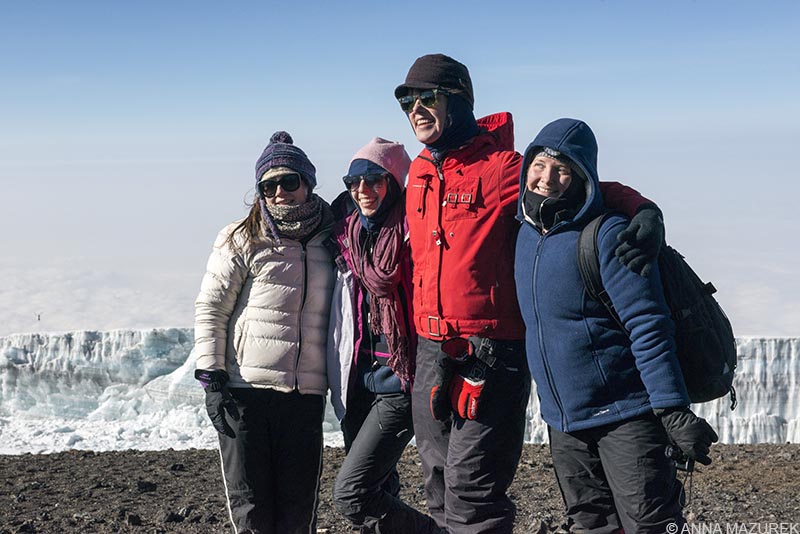
A photo of the girls with Furtwangler Glacier in the background
We slowly trudged through the cold for six hours up the steep, sandy switchbacks. Occasionally, we saw a few people being helped down the mountain, but the majority were going upwards. My stomach started to growl because I was hungry. (I’m the type of person who gets “hangry” fairly easily and needs to eats every few hours.) I felt a little weak and tiny bit nauseous but never got sick. All of these symptoms are typical “hangry” behavior for me. Since I ran photo trips in the Himalayas for five years without any issues, I wasn’t very concerned about the altitude. At this point, I was determined to make it to the top no matter what. There was no way I was walking back down all those horrid switchbacks without having been to the top! (Our guide said he had a 76-year-old women make it to the top a few weeks prior so that was my motivation as well!)
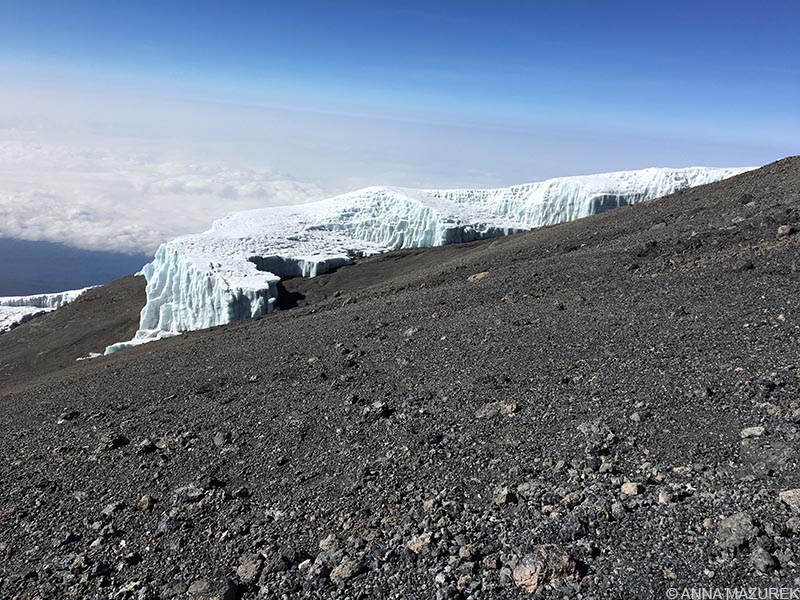
A view of Furtwangler Glacier from the summit. According to a 2012 report by NASA, the glaciers on top of Kilimanjaro are expected to disappear by 2060.
The horizon started to brighten to our right. It was stunning, but I refused to stop to take a photo because we were so close to the top. We reached Stella Point (18,885 feet/5,756 meters) and of course, I had to go to the bathroom. Let me just say that getting those five layers of pants down was literally exhausting at that altitude. (Make sure all your layers aren’t as skin tight as mine!) Our guides wasted no time getting us moving to the second and final peak, Uhuru. While it was only 700 meters away, it took us an hour to walk the mostly flat path. I was the second one to reach the iconic brown sign announcing that we’d made it to the top of Kilimanjaro (19,341 feet/5,895 meters)! The one thing that surprised me the most was the mob of people pushing and jumping in front of each other just to get a photo at the sign. I had expected an orderly line, but I assume the rush was to get people to lower altitude quickly. I was still able to get a photo of myself with Alfred at the top and a group photo. (I later learned there was a second sign 10 minutes down the path.)
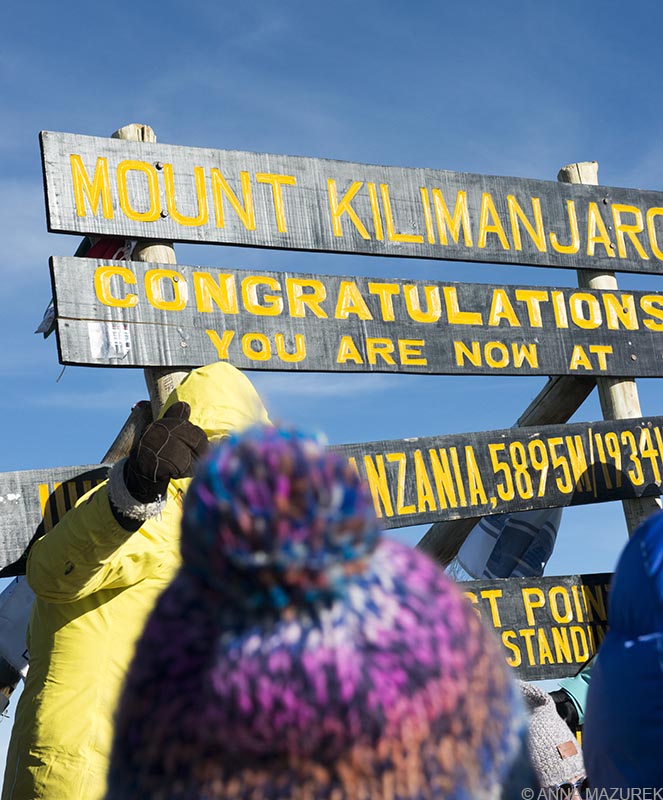
It’s difficult to get a photo at the sign at top due to all the crowds.
Everyone in our group made it to the top! (Our route, Lemosho, has one of the highest success rates.) We went back to Stella Peak and took a few photos before heading down the dreaded gauntlet of steep sandy switchbacks. It took me a little less than three hours to get back to camp. I stopped several times to shed layers of clothing. My CamelBak defrosted and started working again. This downhill stretch was probably the worst part because I was exhausted and the hangriest I’ve ever been in my life. I went back to the tent and passed out for an hour nap then we ate lunch. I felt so much better after napping and eating.
After lunch, we had to trek another four hours to Mweka Camp at 3,100 meters/10,170 feet for our final night on the mountain. By descending in altitude so much, we avoided any issues with altitude sickness. We were all weak and slept amazing that night.
Day 7 – Mweka Camp to Mweka Gate (End of Trek)
Altitude: 3,100 meters/10,170 feet; Distance: 10km/6.21 miles; Time: 3 hours
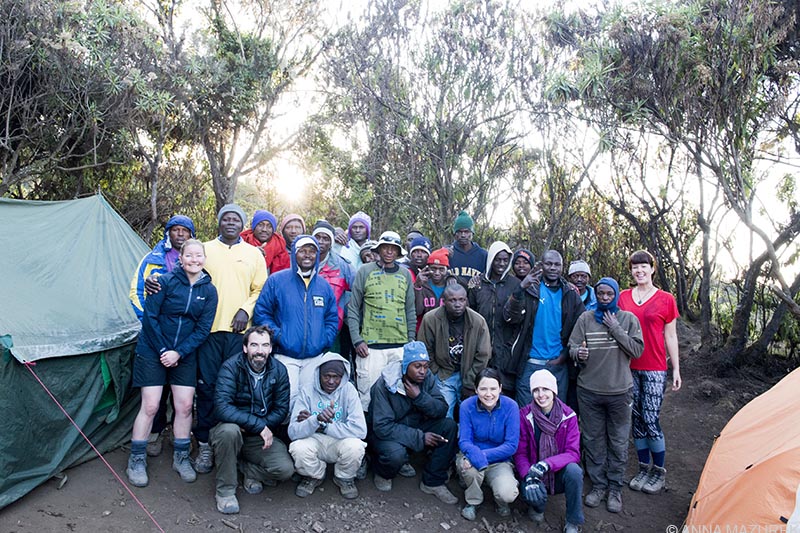
We never would have made it to the summit without our amazing guides and porters. It took 21 people to get the five of us to the top of the mountain!
We woke up at sunrise to sad news. An older European hiker had died of asthma issues on the mountain that morning. All the porters were gathering to help carry the body down the mountain. (There’s a series of wheeled carts that resemble stretchers for getting injured people down the mountain.) I tried to find a news story after we got back but can’t find anything online about the hiker.
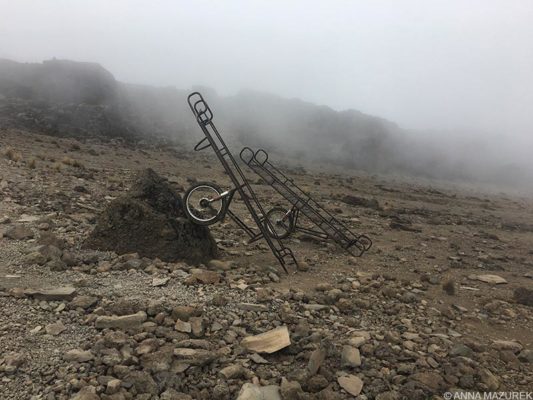
These carts are scattered around the Mweka Route and are used to transport injured people down the mountain.
Our hike to the gate and the end of our trek was only about three hours through the rainforest. At the gate, we took photos with the sign, signed the book to say we’d left the mountain and waited to get our official certificates. We were stuck there for over an hour and finally made it back to Moshi that afternoon. They were out of certificates so our guide brought them to us at dinner. (You always have a big dinner with your guides the night you finish
your trek.)
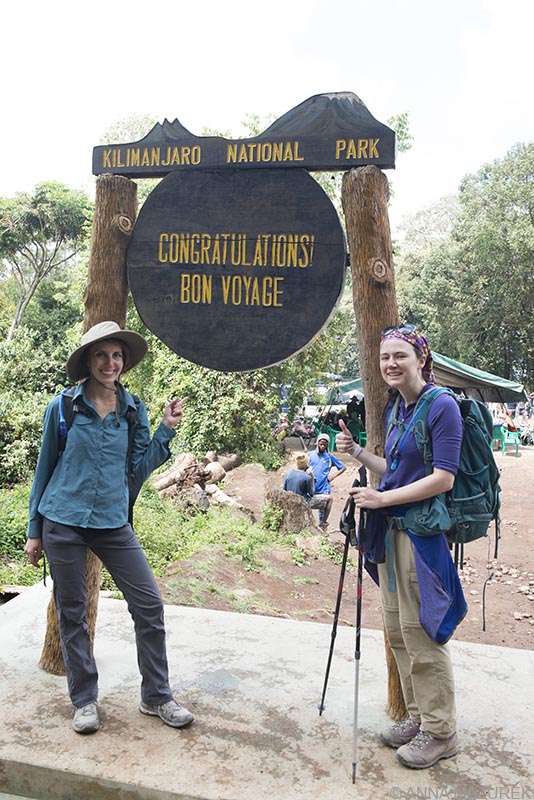
Becky, right, and I celebrate our success. I’m so grateful she invited me to join the trek!
Of course, the water was cold when I went to take a shower the first time so I decided to grab a beer and a snack instead. Afterwards, the water was hot. That beer and shower were probably the best in my life.
In the end, the hardest part was summit day. The rest of the trek wasn’t so bad. It’s not something I would do twice. I might do Everest Basecamp. Although, it’s lower, it involves steeper climbs but allows you to acclimate to the altitude better so it’s not as rough.
It took a crew of roughly 20 people to get us up the mountain including 16 porters for our luggage and supplies. We had one main guide, three assistant guides and a cook. These guys are some of the strongest and most amazing people I’ve ever met. They would totally survive a zombie apocalypse. I trusted them with my life the same way I trusted my guides and drivers in India. They know the mountain better than anyone and earned my respect.
__________________________________________
COMING UP NEXT
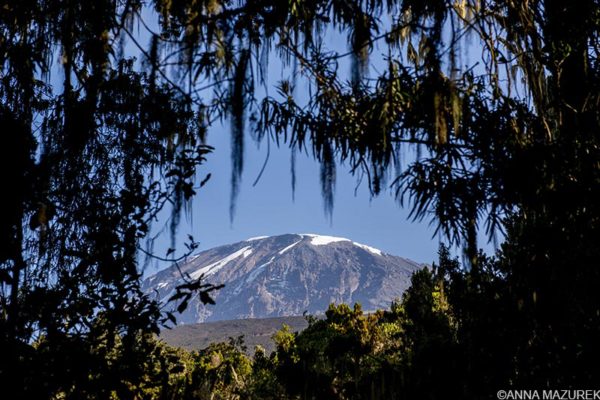
Kilimanjaro 101: Cost, Routes & Packing Lists
In my second Kilimanjaro post, I breakdown all the details about the trek including the cost of my trip, when to go and a list of the main routes. I also provide a detailed packing list based on my experience and offer suggestions of what to buy.
__________________________________________
P.S. I am not sponsored by any of the brands or products I mention in posts. I only recommend products that I love. Please note some Amazon affiliate links are included above. If you click on a link and make any type of Amazon purchase, I earn a small commission with no additional cost to you.
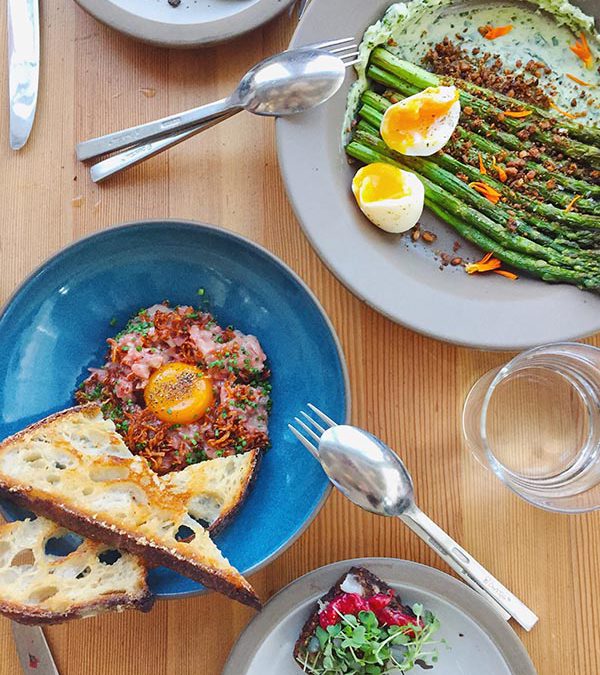
Where to Eat in San Francisco

In this week’s Travel Tuesday Interview, I chat with Danielle Walsh, senior editor at the San Francisco-based travel magazine, AFAR! She dishes all the details on the Bay Area’s best eats and shares some of her drool-worthy Instagram photos. Danielle is one of my editors at AFAR and has one of the best food-based Instagram accounts out there!
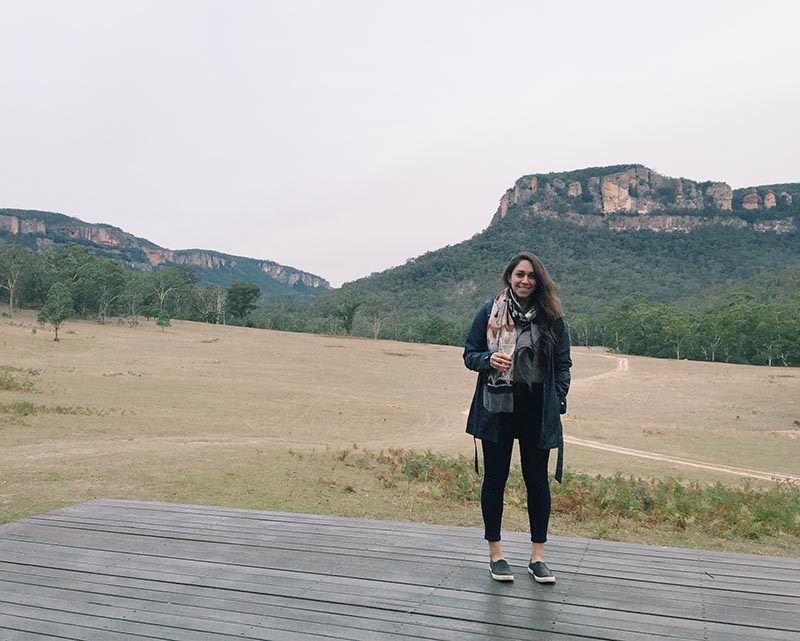
AFAR senior editor Danielle Walsh spent some time in the Blue Mountains in Australia sipping wine and looking for kangaroos.(Photo courtesy of Danielle Walsh)
Name: Danielle Walsh
Age: 28
Hometown: Boston, MA
Country count: 11
Instagram: @wandereatrepeat
1. How did you start traveling?
My first adult international trip was to Italy, but I feel like I wasn’t truly a traveler until I went to Istanbul. That city is so intoxicating. The smells, the gorgeous architecture, the palpable history—it’s sensory overload. It made me crave experiences that got me out of my comfort zone. I remember wandering into a subterranean antique shop in the Ortakoy and meeting its owner, a man who was roughly in his early 50s. He didn’t speak English very well, so he went around the corner to find a neighbor who did, and translated our conversation. He told me his daughter was attending Harvard. He was delighted to find out I was from Boston. It was one of those travel moments you can’t plan or pay for!
2. What single dish best represents the city of San Francisco? And, where can we get it?
Zuni Café’s chicken with bread salad. It’s a classic. I’ve been saying lately that San Francisco is the chicken capital of the country because of the many restaurants that have excellent chicken dishes they’re famous for.
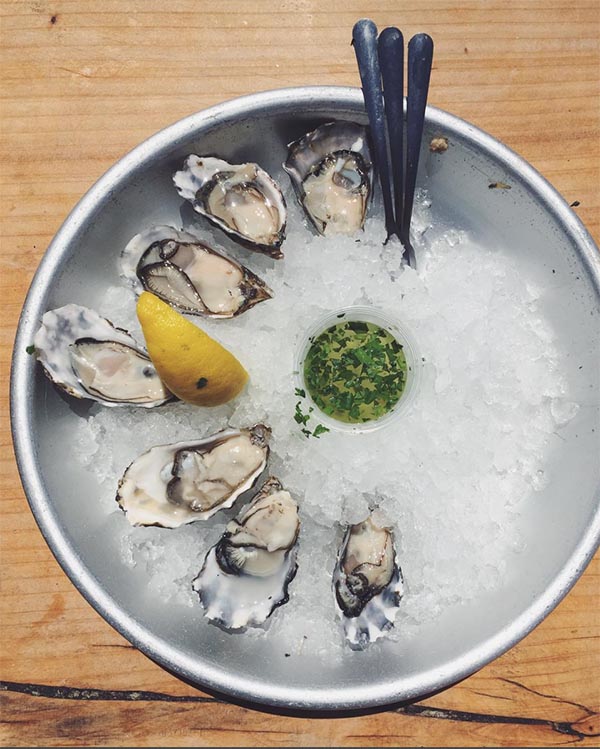
Marshall Store Oysters near Point Reyes, California (Photo by Danielle Walsh)
3. What are three iconic places everyone must eat on their first trip to San Francisco?
A great, no-fuss taqueria (La Taqueria or El Farolito), Nopa for a fancier dinner, and Cotogna for some of the best pasta around and the fantastic approachable wine list. Bonus points: Drive up to Point Reyes to go to Marshall Store or Hog Island for oysters.
4. Share some tips for eating on a budget in San Francisco.
San Francisco has so many awesome fast-casual places to eat. My personal favorite is Souvla, a Greek spot that specializes in homemade wraps and salads with delicious roasted meats—all washed down with affordable Greek wine. Another great spot is Media Noche, which has the most delicious Cuban food on this coast. Recently opened is RT Rotisserie, where you can get sandwiches and rotisserie chickens. I think SF has really figured out how to make the affordable counter-order restaurant super special. Also, many restaurants have no-corkage nights—one of my favorite spots that’s mostly filled with locals is Zazie. Tuesday nights, you can bring in as many bottles as you can responsibly drink. The food is great, and they have a lovely back patio area.
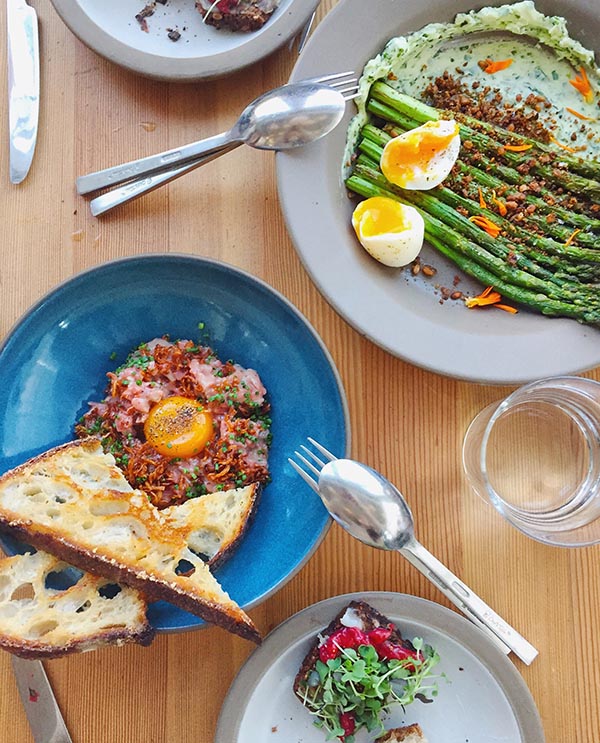
Tartine Manufactory offers one of the most interesting meals in San Francisco. (Photo by Danielle Walsh)
5. What are your three favorite places to eat in the city right now?
- Tartine Manufactory. Believe the hype. It was the most interesting meal I’ve had in San Francisco to date.
- Flores. It may seem flashy and big-production, but it’s a take on Mexican food that’s just really good and exciting.
- Nopa. It’s always nailing it, whether it’s brunch, dinner, or late-night eats. I recently went there after a concert and happily scarfed down its $20 burger and a sour beer from Russian River Brewing Co.
6. What local ingredients would you pack for a picnic in Golden Gate Park?
- Cowgirl Creamery Mt. Tam cheese
- Any loaf of bread from The Mill
- Scribe Winery’s 2015 rosé
7. Share one of your favorite culinary adventures in the city.
Eating, drinking, and shopping your way down Divisadero street. Many of my previous recommendations can be found there.
8. What’s the biggest myth about San Francisco?
That it’s not walkable. It’s only 7 by 7 miles and has some of the most beautiful streets and parks in the country! On the weekends, I’m always walking to wherever I need to go—hills and all. My fiancé and I call it “urban hiking” and that way, we can totally justify our weekend gluttony.
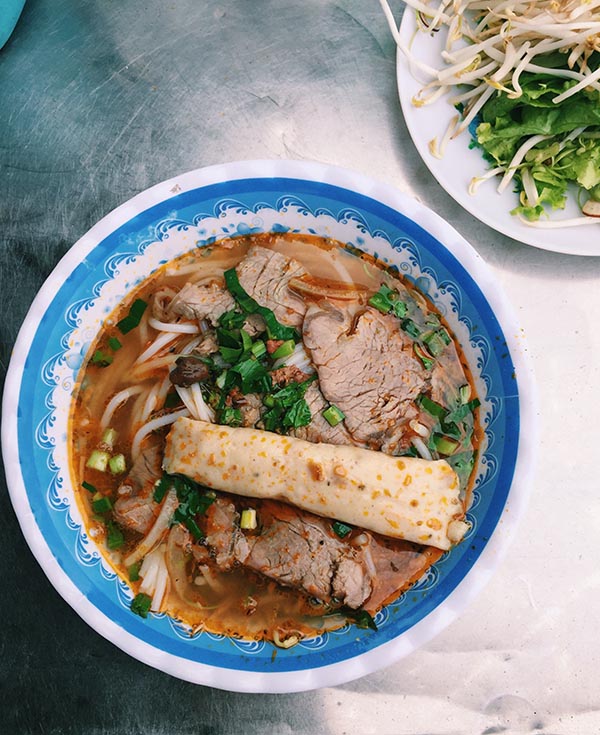
Spicy Vietnamese soup was one of Danielle’s favorite dishes in Ho Chi Minh City. (Photo by Danielle Walsh)
9. What are two of your other favorite food cities?
- New York. I used to live there and just love its dining scene vibe. People really dress up for dinner there. Here, people roll into a tasting-menu dinner in yoga pants and Warriors jerseys which makes me LIVID. Plus, it’s home to Roberta’s, my all-time favorite restaurant.
- Ho Chi Minh City. I could live off of Southern Vietnamese street food—spicy beef noodle soups, namely—for the rest of my life.
10. What is your next adventure?
My honeymoon! Thinking Fiji and Hawaii. For once, we’re not traveling for the food—we’re traveling to be far, far away from everything after the craziness that is planning and executing a wedding.
__________________________________________
COMING UP:
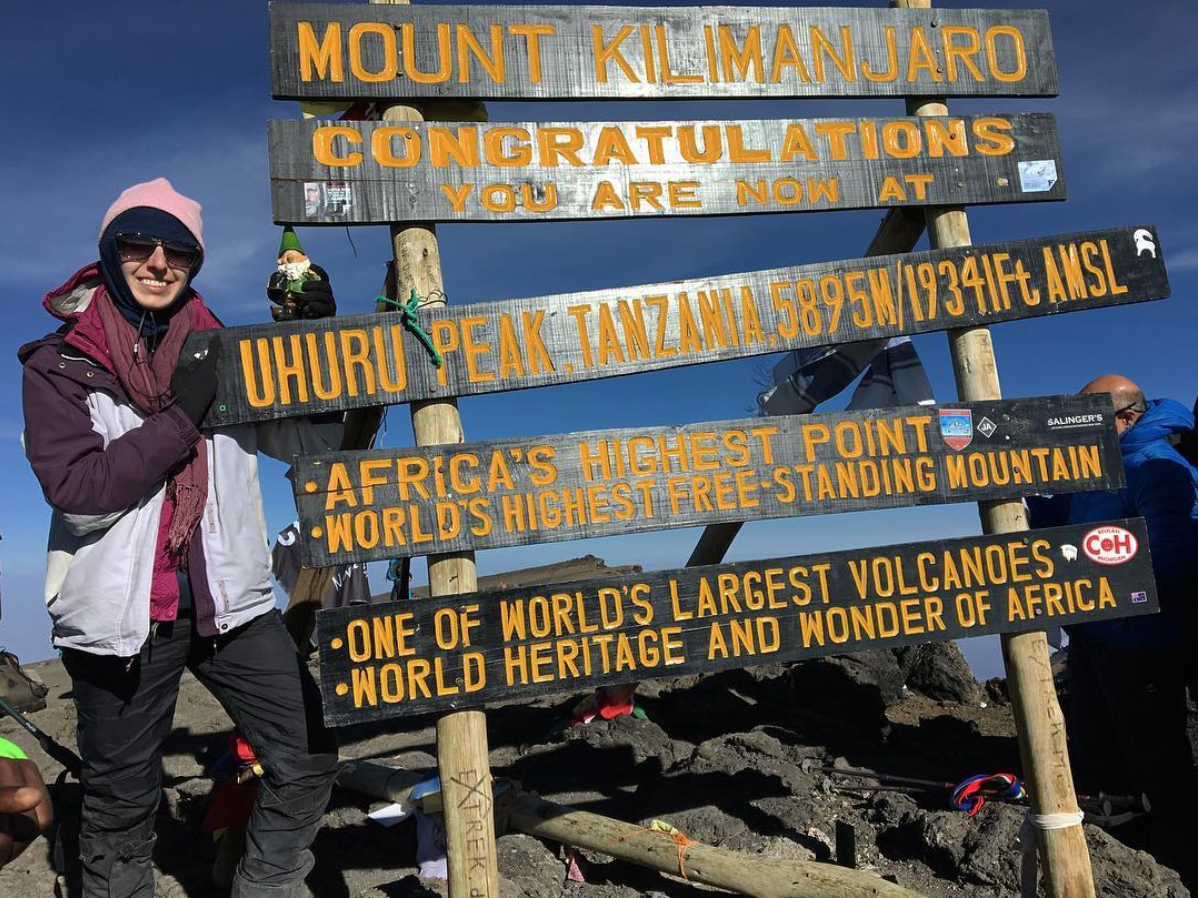
What It’s Like to Climb KILIMANJARO
I just got back from climbing Kilimanjaro! I’m currently working on two detailed posts about my journey: a day-by-day guide to the trek and how to prepare for your own journey. (I’m headed to Santa Fe and Albuquerque this weekend for the hot air balloon festival and to go hiking! Follow along on Instagram!)
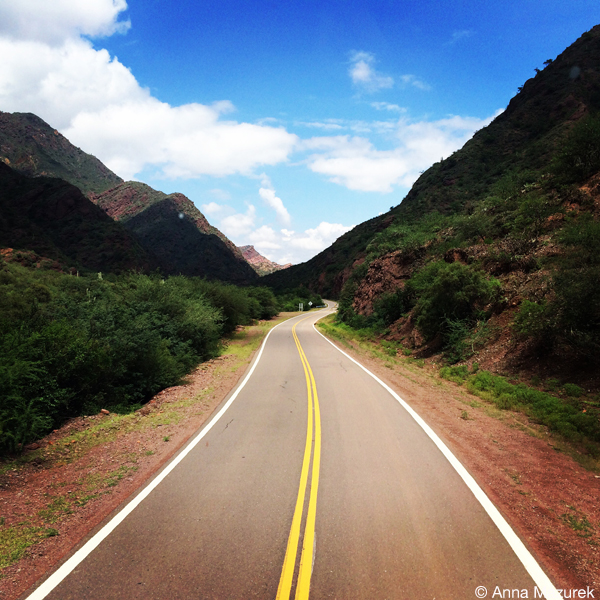
Six Epic Road Trips
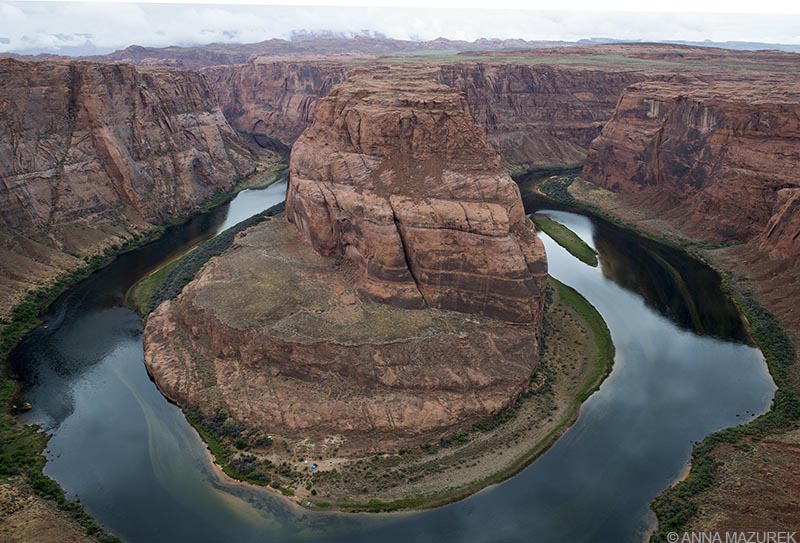
Horseshoe Bend is 3.9 miles south of Page, Arizona. It’s a short 3/4 of a mile walk from Highway 89 to the rim.
There’s nothing I love more than a good road trip. If you’re looking to squeeze in a last-minute trip this fall or searching for a few places to escape the winter, here’s a few of my favorite road trips of all time:
1. Southwestern U.S. (New Mexico & Arizona)
Arizona and New Mexico won the scenery jackpot. Last year, I did two big road trips through this part of the country. There’s many hidden or lesser known spots that are equally amazing as the famous spots minus the crowds. Catch a full moon at White Sands National Monument, drive the bumpy dirt road to Chaco Canyon, download a GPS map to explore the Mars-like rock formations at Bisti Badlands. Plus, there’s Antelope Canyon in Page, Arizona and Horseshow Bend, pictured above, right off the highway. Albuquerque hosts a huge hot air balloon fiesta every October, which I personally love so much I’m going back this year!
LOGISTICS: Start near Santa Fe/Albuquerque then head West to Page, Arizona. Both the Santa Fe/Albuquerque and Page areas are a great base for day trips. After Page, head south to Phoenix before heading West to White Sands National Monument.
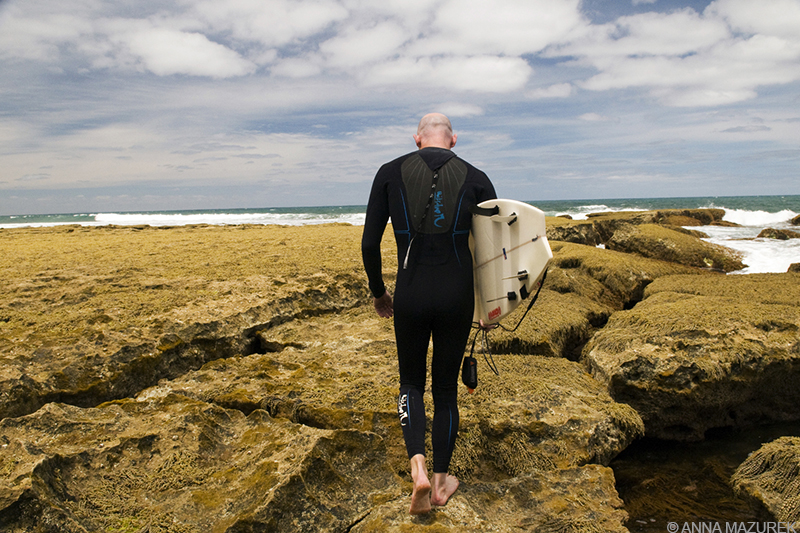
A surfer walks across the rocks at Bells Beach, a world-renowned surfing spot located on the Great Ocean Road west of Melbourne.
2. Australia’s Great Ocean Road
When I lived in Sydney, two friends and I rented a car and drove this stunning 249-mile stretch of coastal highway along the Southern coast of Australia from Melbourne toward Adelaide. It’s lined with cliffs and scenery that rivals California’s Pacific Coast Highway. At the time, I was pretty broke, but it was one of the best road trips of my life. We slept in our rental car, drank beer on beaches, ate peanut butter sandwiches and snuck into RV parks to shower. We stopped at all the well-known spots – the renowned surfing mecca of Bell’s Beach, the iconic 12 Apostles rock formations and national parks filled with koala bears in trees.
LOGISTICS: The Great Ocean Road starts west of Melbourne in the tiny town of Torquay and ends in the fishing village of Port Fairy. I would recommend three days to do this stretch to have time to explore the area and return to Melbourne. Consider continuing to Kangaroo Island and Adelaide.
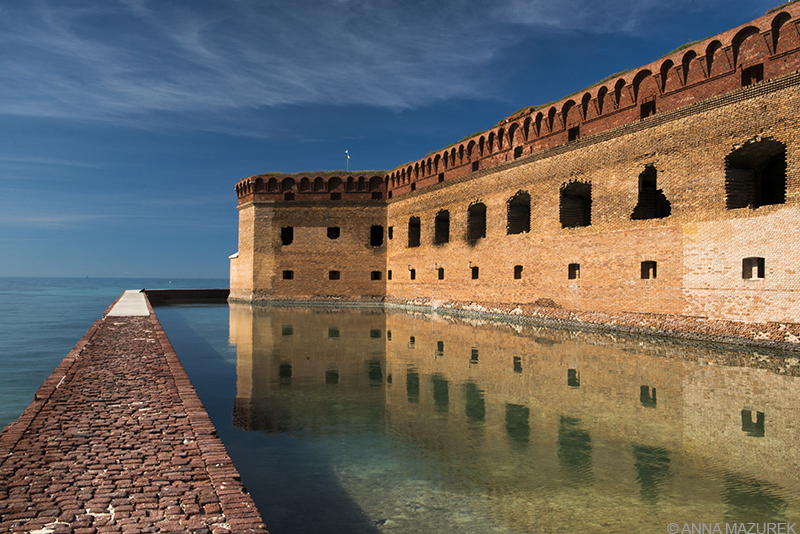
Fort Jefferson is an unfinished 1800’s fort located in the Dry Tortuga’s National Park, which is accessible from Key West by a daily ferry, sea plane or private boat.
3. Florida Keys
The best way to see the Florida Key is to grab a few friends, fly into Miami, rent a car and sing-a-long to Jimmy Buffet the entire way. Be sure to stop at famous spots along the way including a few of my favorites: Mrs. Mac Kitten, a roadside diner known for their Key Lime Pie; No Name Pub, a dive bar on Big Pine Key covered floor to ceiling with dollar bills; Hemingway’s House in Key West and Dry Tortugas National Park, one of the most remote National Park’s in the U.S.
LOGISTICS: While you can fly into Key West, it’s cheaper to fly into Miami and rent a car there. (It’s 160 miles from the airport to Key West, which is roughly a three hour drive in traffic.) Take your take making your way to Key West and stay at various islands along the way.
(Please note that this post was written before Hurricane Irma hit the region. While the Keys were hit hard by the hurricane, I know they will endure. I encourage you to support the hurricane relief efforts by donating to charities and using your tourism dollars to visit the area once it reopens for travelers.)
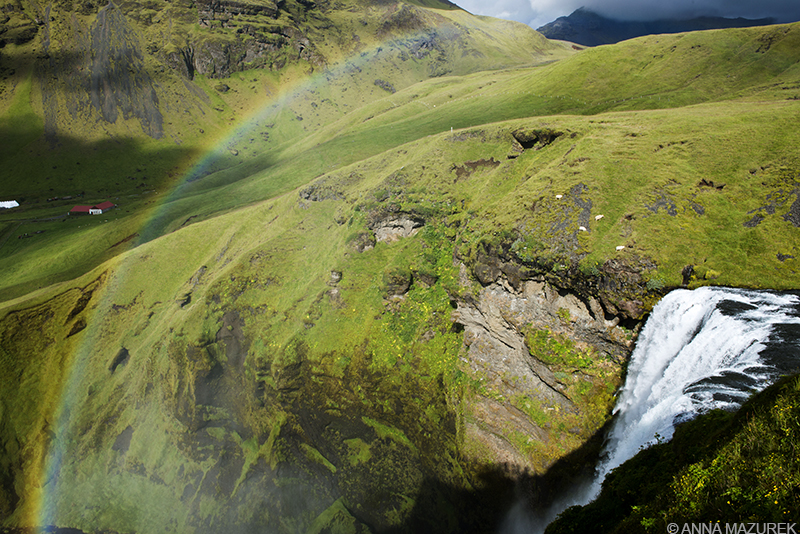
The view from the top of Skogafoss waterfall in Southern Iceland is worth the climb!
4. Iceland’s Ring Road
Iceland is literally perfect. The scenery is stunning. The people are the nicest. It’s the only country without mosquitoes. It’s also the safest country in the world. Did I mention there’s NOT a single mosquito?
The best way to see Iceland is to drive Route 1, known as the ring road. The two-lane paved road is an 828-mile loop around the country with a 55-mph speed limit. Highlights include puffins on the cliffs Dyrhólaey in the summer, the glacier lagoon at Jökulsárlón, Kirkjufell, the most photographed mountain in the country, and Siglufjörður, a small fishing village located in a scenic fjord accessible only by a scary one-lane tunnel with two-way traffic. Decide what you want to see and decide accordingly by the season.
LOGISTICS: Drive counterclockwise exploring the southern part of the island first. It has the largest concentration of sights and tourists. Be sure to venture off the main road to explore the scenic Snæfellsnes and Trollaskagi pennsuilas. Allow at least a week to do the drive. Check out my Iceland Guide for more details.

Argentina’s famous scenic drive known as Ruta 40 is almost a 1,000 miles longer than Route 66.
5. Argentina’s Longest Road
Patagonia was one of main three places I had to explore on my South America trip. I traveled by bus from the southernmost tip of Argentina to Cusco, Peru over the course of a few months. During that trip, we drove down a portion of Ruta 40, Argentina’s longest road that stretches 3,246 miles from the southernmost point of the mainland to the Bolivian border in the north. The road manifests the same aspirations and nostalgia as Route 66 in the U.S.
LOGISTICS: The best way to see the road is to drive, but keep in mind the entire road hasn’t been paved and is gravel at points so a 4WD vehicle is recommended. Many bus routes follow parts of the paved portions of the road, which is a good alternative. For a breakdown of the best route to drive, check out this post by Rough Guides.
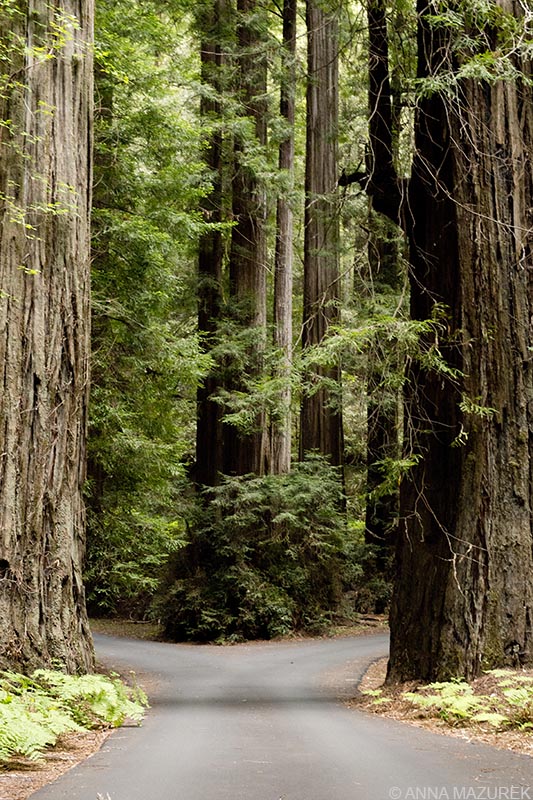
California’s Humbolt Redwoods State Park is home to some of the world’s largest remaining contiguous old-growth forest of coast redwoods.
6. California
I have a love-hate relationship with California. I love it because it’s beautiful. There’s an endless plethora of stunning locations to photograph – Yosemite, the Redwoods, Big Sur, etc. One the other hand, I hate it because it’s outrageously expensive to live there. (I lived in Santa Barbara briefly and quickly learned that lesson the hard way!) When I visit friends or travel to California for work, I always tack on a small road trip to see something new like my trip to Tahoe a couple weeks ago. It also the ultimate cross-country road trip destination!
LOGISTICS: If you drive the Pacific Coast Highway, I recommend driving north from Santa Barbara. Plan a couple days to stop along the way. My favorites sites are Big Sur, Point Lobos National Reserve near Carmel, Half Moon Bay, Santa Cruz and Point Reyes National Seashore. If you head out to Yosemite or Tahoe, consider visiting Bodie State Historic Park, an old mining ghost town, and Mono Lake to see the unusual rock formations.
__________________________________________
COMING UP:
I’m heading on my first trip to Africa (continent number 6!) next week to climb Mount Kilimanjaro. My next post won’t be until mid-October after I’m back and have a chance to write about my adventure. In the photo above, I’m sitting on the top of Khardung La (18,379 feet), the highest motorable pass in the world, in India.
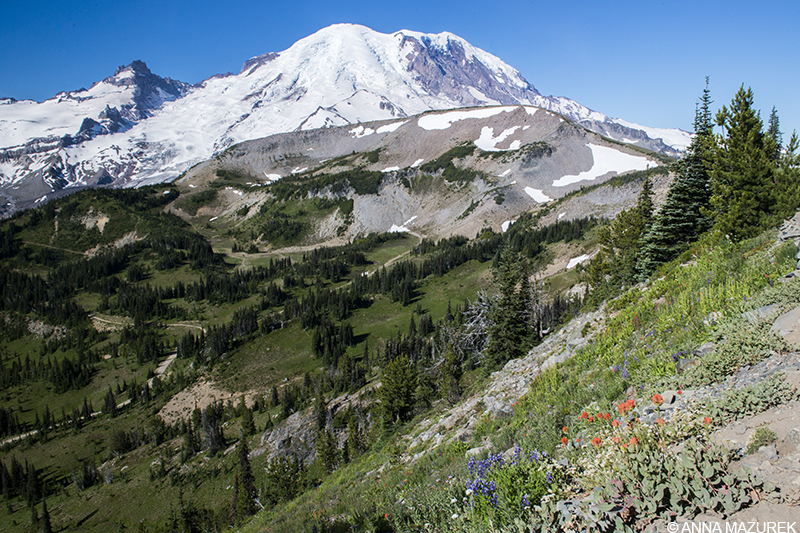
Why You Should Travel NOW

Mount Rainier, Washington photographed in Late July 2017
I noticed the pain in my stomach on a Friday in late March.
I was in the middle of a big corporate photo shoot in Austin. Initially, I assumed that I’d just overeaten at lunch as usual. The pain continued through the weekend. I already had a doctor’s appointment on Monday for a few travel vaccinations so I mentioned it to the doctor, which led to a series of tests. The results found something but further tests were needed to rule out cancer.
Those five days between the two tests were horrible. Our minds are our biggest enemy.
All I could think about was my British friend in Australia who went to the doctor with stomach pain. Less than seven months later, she was gone. Bowel cancer. She was only 30. Her death was a brutal reminder that life is short. It’s been two years, and I still can’t believe she’s gone.
Those five days of worrying before I got the final test results taught me a lot. I started to re-evaluate my life. What if I only had six months left? How would I spend my time?
I would finish teaching the semester, but immediately, quit my side jobs. Then, I’m move back to my parent’s farm. I would take my 15-year-old nephew on a trip to Europe—the trip I was saving for his graduation present. I would build furniture with my dad every day. (He builds 18th century furniture for a living.) And, I’d buy a pair of baby alpacas to raise on my parent’s farm.
Instantly, I was grateful for my travels—46 countries. I didn’t regret a single time I’d quit a job to travel. The only thing I regretted was all time I wasted working jobs I hated because I felt trapped by the good health insurance or the fear of being broke. I was disgusted by all the times fear lead me to inaction.
The results from my tests came in: I had a benign ovarian cyst, which are apparently common. Despite my paranoia, everything was okay with my physical health. It was my mindset that was irrevocably altered.
Here’s the biggest secret in life: The timing will never be perfect. Sometimes, you just have to go do the things you want even if it means quitting your job and selling everything that you own. Who cares if other people think you are crazy? It’s your life, not theirs.
Since I initially wrote this in April, I quit everything that wasn’t helping me move toward my career or travel goals. When my best friend in Tokyo jokingly asked me to climb Mount Kilimanjaro in Tanzania with her in September, I said yes and booked a flight. I’ve never regretted anytime I’ve invested time and money in experiences. No 80-year-old will every say, “Man, I wish I’d stayed home on the couch instead of going to explore the world.”
You don’t need permission to live your life or travel. If part of you still wants permission, then you have mine. That’s why I started this blog. Go now.
Today is my birthday. I’m not getting any younger. This minor health scare was a big wakeup call. I have already lined up some insane adventures for next year and big photo/travel projects that I’ll announce in a few months. Africa will be continent number six for me!
Life is short. Travel NOW!
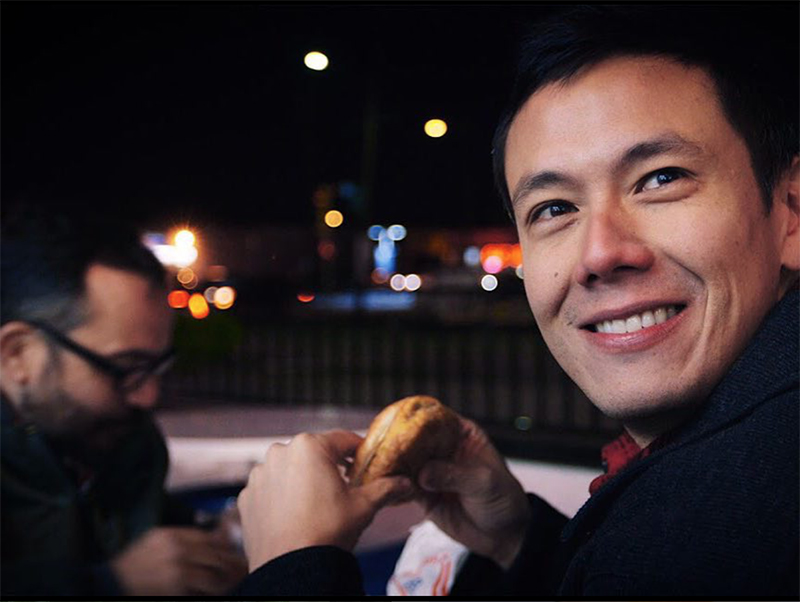
Interview: New York Times’ Frugal Traveler
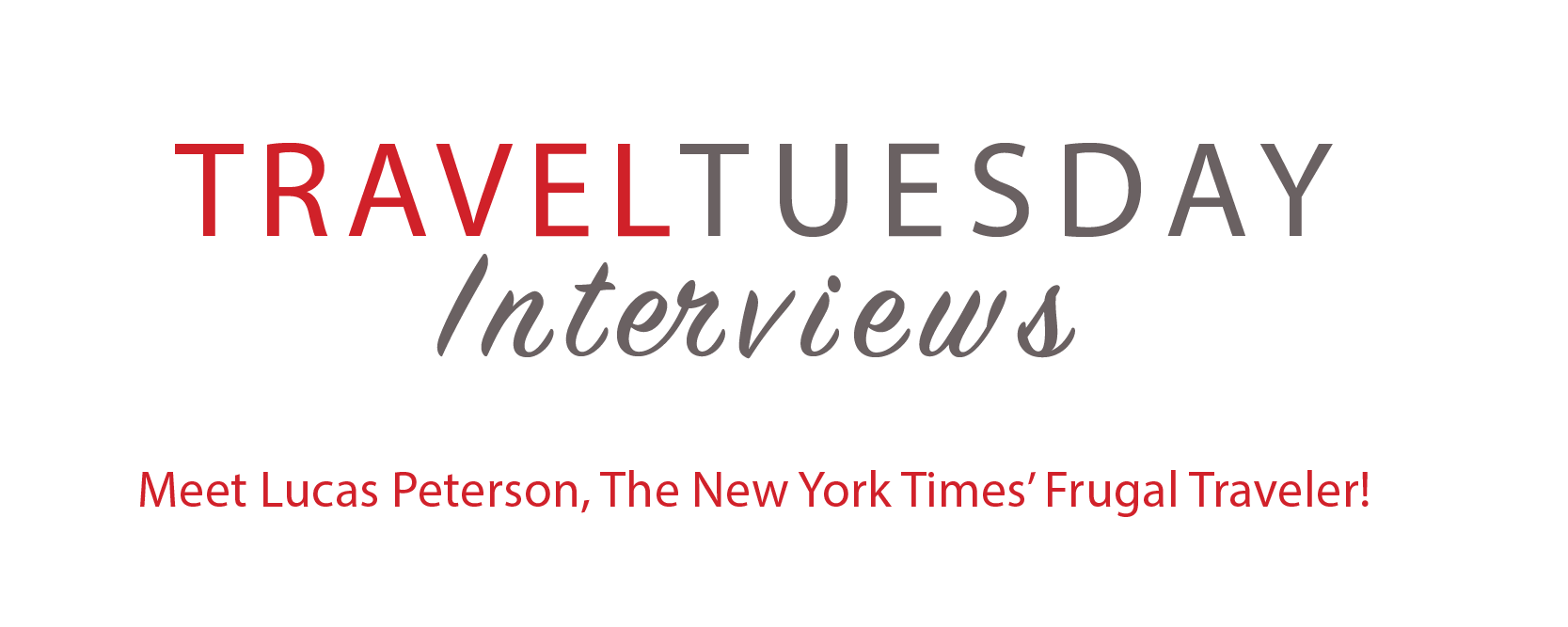
In this week’s Travel Tuesday Interview Series, I chat with The New York Times’ Frugal Traveler, Lucas Peterson! Peterson has been dishing budget travel advice since he took over the reigns of the column an year and half ago. He discusses his favorite food cities, his travel highlights and his travel budget philosophy.

Lucas Peterson is based in Los Angeles and took over the Frugal Traveler column in 2016. Photo courtesy of Lucas Peterson.
Name: Lucas Peterson
Hometown: Oak Park, Illinois
Current home: Los Angeles, California
Country count: At least 30
Website: nytimes.com/frugaltraveler
Twitter: Lucas Peterson, Frugal Traveler
Instagram: StaleTwizzlers
[This interview was conducted over the phone, transcribed and edited for length.]
1. How did you start traveling?
I was lucky enough to travel a lot when I was a kid. My parents frequently traveled for work. When I was kid, I got to tag along on a couple of trips [including Egypt and China], and I think that was the what inspired a love of travel when I was young
When I was 16, I was an exchange student. I lived in Netherlands for a year. Then, I lived in China when I was 19. I got a job at a hotel there and worked there for a year. I did The Peace Corps in Central America when I got out of college. I’ve sort of always liked it. It’s always been an interest. I have my parents to thank for that.
2. What does your average work day look like as the Frugal Traveler?
Man, it depends on the day. Imagine a little flow chart, then you go down a certain path where the first question is “Are you on the road?” Yes or no. If yes, then things are a little more busy. Obviously, I’m in a place with a limited amount of time on the ground, trying to go see things and have as many different experiences as I can. Then, very aggressively taking notes wherever I go. Those days are busy. I have very busy stretches of time when I’m on the road. Then, also, usually I’ll try to piggy back trips on top of the other.
I live in L.A. so if I go to Europe. I’m not going to go Europe for one story. I’m going to try to get a few different stories out of a trip. Usually, I’m going to a couple different countries. Then, if you combine that with having to be filing stories from the road, which I frequently am, then, it gets really busy. So, I will be out all day working and stuff. Taking notes on stuff, traveling around, then trying to have the notes in order and getting back to wherever I’m staying. If I’m staying at a hotel and then, [I’m] trying to write a story about a place I was at some months ago, which is tough. I get confused especially if [I am] in a totally different place. Those times can be pretty tough.
When I’m not traveling, sometimes I have days that are pretty free. But, I’m still filing stories when I’m at home. I’ll typically have a story I’m writing every week. When I’m writing a story, then there’s different rounds of edits. I do have other freelance writing obligations. I do a video show. I do a food show for a site called Eater. Every now and then, I’m shooting that show as well.
That’s the long answer. The short answer is It depends to the day.
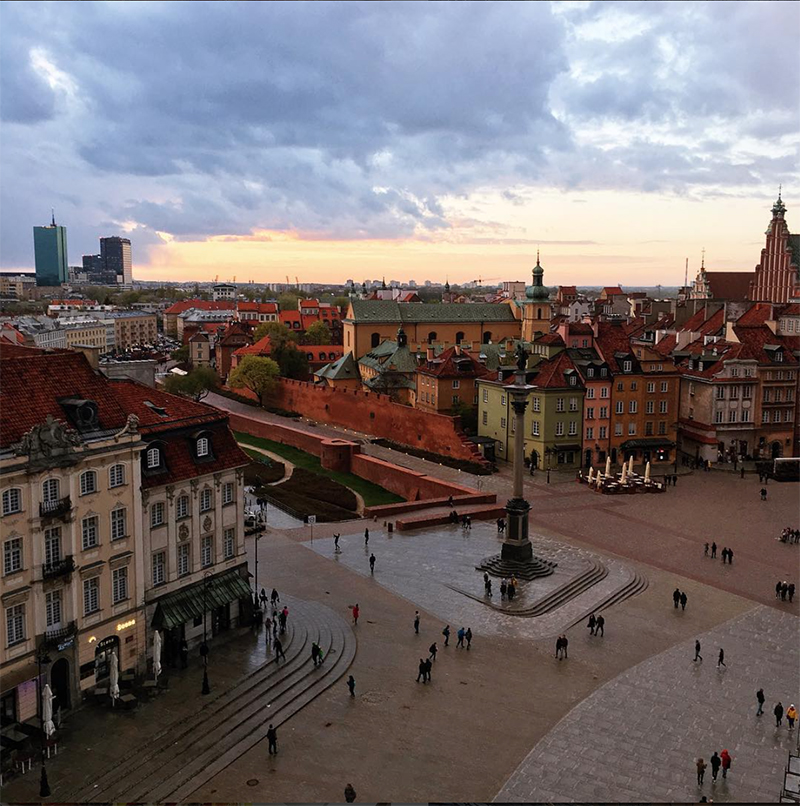
Europe is a lot more accessabile to budget travelers according to Peterson. The highest cost is always the flight. Photo credit: Lucas Peterson
3. What is your average daily budget for traveling?
There is no budget. It’s funny. The reason why [some publications] don’t give a budget is they don’t want people spending up to that budget. They sort of trust me to keep costs low and under control. I’m pretty good at finding deals and stuff. It’s interesting, no set budget.
If you’re traveling on your own budget, would it be the same?
I don’t have super luxurious tastes so it’s never really been an issue. If I were on vacation for myself, I don’t know. It would depend on where I was going. If I book a flight, I feel like a $1,000 is some arbitrary magic number for going to a place roundtrip. If I could spend a little more, get a better route, a nonstop or if I could save a ton of money…make two stops and add 15 hours to my trip, would I do it? Maybe I would.
I don’t operate necessarily as far as dollar figures. There’s no real magic numbers in my head at least when I’m traveling.
4. Can you share your top two tips for traveling on a budget?
Everyone sort of has a different set of needs and desires when they travel for fun. One [thing] that I like to do for fun anyways is I go to Google Flights, and I plug in some dates. And, then, I just look at map of world, and I look at prices. I like to see where can I go. Where can I possibly go and how much would it cost? It’s a good way to get the lay of travel land. If you’re saying to yourself, “I have a week in September.” You put that into Google Flights, and you leave the destination blank, and you can see everywhere you can possibly go and how much it will cost you.
It’s a super good way of getting sense of what’s possible and what’s out there. It really depends on the season. It really depends on where you want to go.
If you want to go to Paris in June, you’re going to pay. There’s no real way around that. You are going to pay in a range of prices. You’re not going to find a deal, whereas, if you go in September you [could] go for extremely cheap. When I travel, I like to use the bargain sites. I like to do the bidding sites like Priceline and try to find deals. Hotels.com had a thing where you would buy a $50 gift card for $40. [I’m on top of] where you can save $10 or $20 here and there.
I like to eat cheaply. I like to eat on the street depending on where I am. If I’m in Peru, and there’s someone making delicious looking juice on the street, I will not hesitate to drink it. There’s certainly risks involved. But, I love to eat on the street. It makes the connection between you and the place. You get a real sense of what it’s like to live there. You are interacting with people. The other benefit is that it’s super-duper cheap.
There’s no real secret. I mean there’s no one cool trick to get super cheap travel. It doesn’t happen. The more time you spend monitoring airfares, at some point, the law of diminishing returns comes in. You aren’t exactly going to get a killer deal on a flight to London because it’s hard. Your time is better spend thinking about what you are going to do on the ground.
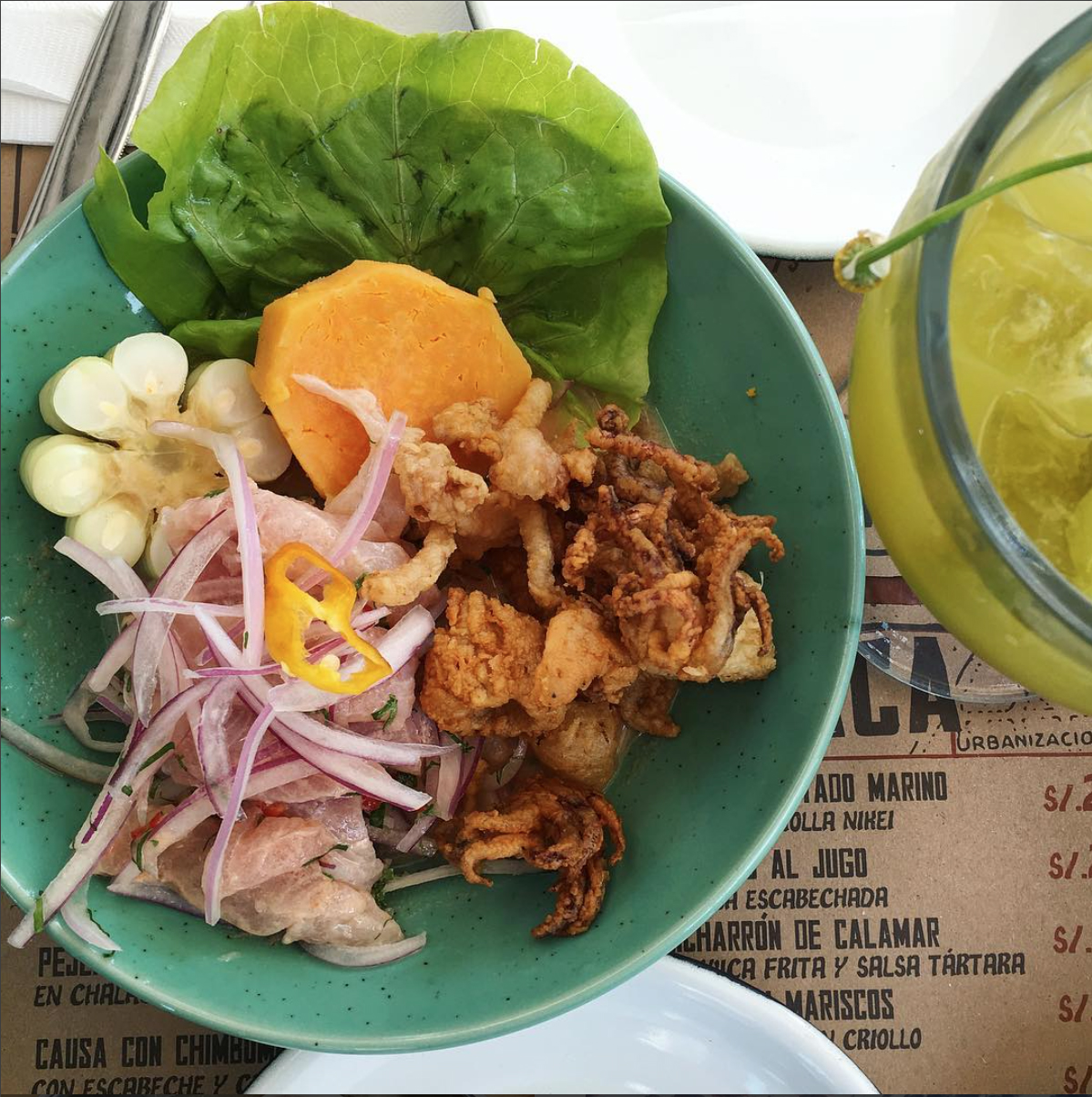
The Frugal Traveler was a big fan of the food in Lima, Peru especially the ceviche! Photo credit: Lucas Peterson
5. Give us your picks for the three best food cities.
It’s hard to beat China. I’ve spent time in Hong Kong, Shanghai, Beijing. It goes without saying that you have to like Chinese food.Paris is amazing. Do you love pastures and dairy? Yes, then you’ll love Paris.
I spent some time recently in Southern Spain and Portugal, and the food there is top notch. It is also super-duper inexpensive. I also really just love the culture there. You have a little snack and cup of wine for a 1.50 Euro and then, you walk around for a few hours. Then, you have another snack with a glass of beer. And, it’s all pretty cheap. There’s this culture that every few hours you have a glass of wine and a little snack. I really loved eating there. Then, I was just in Lima, and they have incredible ceviche.
It’s hard to pick three. I’ll pick China, Southern Spain and Portugal, and Paris. And, Lima. I’ll pick four.

Europe is a lot more accessabile to budget travelers according to Peterson. The highest cost is always the flight. Photo credit: Lucas Peterson
6. Name a few of the best budget friendly destinations.
A lot of Europe is very accessible right now. A lot of it depends on getting down there. Once you are there, things are great. It’s just sort of an issue of finding that airfare. So, obviously, I did just got back from Peru, which I wholehearted recommend. It was super good. Just a rich country as far as geographically. You’ve got Lima on the coast, which is also sitting on the edge of desert. You’ve got Cusco in the mountains and if you go up to Iquitos, [you’ve got] the Amazon. It’s easy to pop around when you’re there. There are local air carriers. I never had any problems getting around. The ceviche is really good. I took like a surfing lesson, which was super fun. That’s one place that I love.
As far as cheap airfare, it seems like Iceland is the inverse from everything I’ve heard. I’ve never been, but from what I’ve heard, it’s extremely cheap to get there and once you’re there, it’s expensive.
7. Share one of your travel highlights.
In my life, I got spend about a month traveling in Syria and Jordan when I was in college [in 1999]. They were both beautiful. Jordan was beautiful. The desert scapes, going to Petra and spending the night in the desert in this tent was a fantastic experience.
Going to Syria. We went to Damascus and Aleppo. Those are the two most beautiful cities I’ve ever been, too. The people were kind, the cities were fantastic, and the food was great. It totally breaks my heart that we can’t go back, at least anytime soon. And, Aleppo is gone. That will always be a wonderful memory for me. We had a guide showing us around. I don’t know where he is. I don’t know if he’s alive. I hope he is. It’s just a wonderful country with just warm people. It’s just so tragic what’s happened. I’m very thankful for the time I got to spend there.
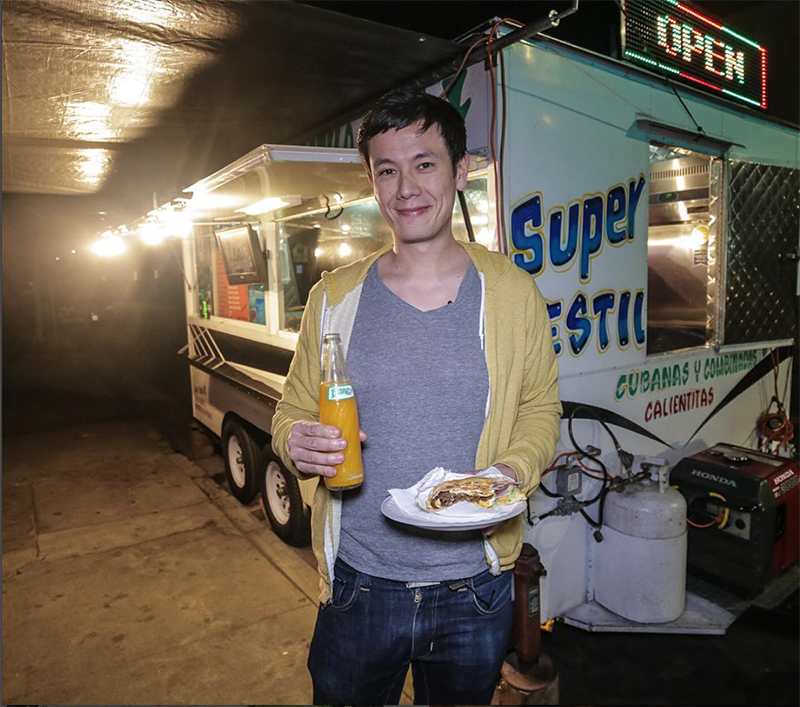
Peterson contributes his love of street food to his ability to travel frugally. Photo credit: Lucas Peterson
8. What is the biggest myth about budget travel?
The biggest myth is that it has to be uncomfortable. People have an image of “I’m going have a giant backpack. I’m going to be trekking and sleeping on planks or sleeping on the floor and being very uncomfortable. And, crammed in a room with seven backpackers.” For some, people that works. For me, that’s not always what I want. I don’t always want to have backpacking experience That’s useful in some ways.
I think can travel inexpensively and still have a comfortable experience. And, still not have to have a flight with 20-hour layover in Frankfort or whatever. At some point, cutting corners and trying to travel as cheaply as possible at some point comes around to bite you, in my opinion. You can always do it more cheaply.
For a lot of people, you have decide what your time is worth. Maybe you have a limited amount of time in the county. Yeah, you can do it more cheaply, but what’s the cost?
The myth about budget travel, number one, is that it has to be super uncomfortable and, nu mber two, that it’s a race to the bottom to see who can spend the least amount of money. At least for me, I find that when you do that, you frequently have to sacrifice a lot as far as the pleasurable amount of the experience and a lot of your time.
9. Name three things you always pack for a trip.
- Portable phone battery charger. I don’t know what I did before that. It’s saved my life so many times.
- Belt with a plastic buckle. It sounds stupid but going through security, I feel like every little inconvenience counts.
- Plug adapters
- LifeStraws water filter (depending where you are going)
10. What is your next adventure?
I don’t really know yet. I’m sort of in the process of figuring it out. I’m pretty sure it’s going to be sub-Saharan Africa. Possibly an African safari, South Africa. I would definitely love to spend some time in that region in Mozambique, Zimbabwe, Botswana and around there. It’s not totally planned.
To read more about Lucas Peterson’s adventures and tips, check out his Frugal Traveler column.
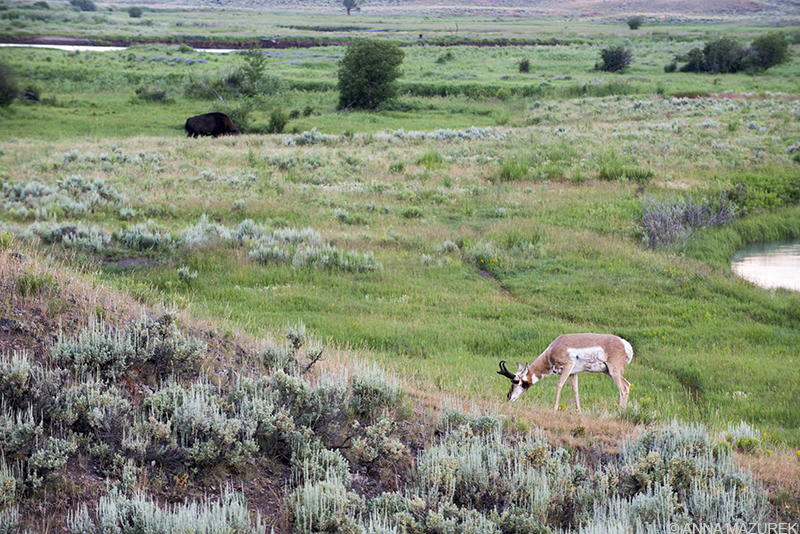
Things to do in Yellowstone National Park
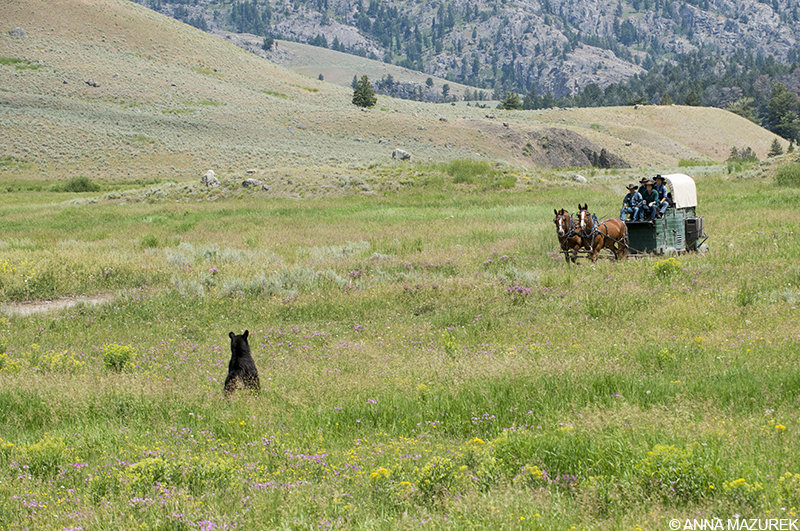
A black bear stands up to greet a wagon near the Roosevelt Lodge in Yellowstone National Park. There were black bear sightings two days in a row near the lodge during our trip.
Despite being on my bucket list, I kept pushing back my plans to go to Yellowstone National Park. My goal was always to take two months and do an epic road trip through the major national parks in the Western U.S. The summer of 2019 was the plan. Then, National Geographic Student Expeditions offered me a position to run a Yellowstone Photo trip. Clearly, I said yes instantly. Here’s the best things to do in Yellowstone National Park and how to avoid the crowds in Yellowstone.
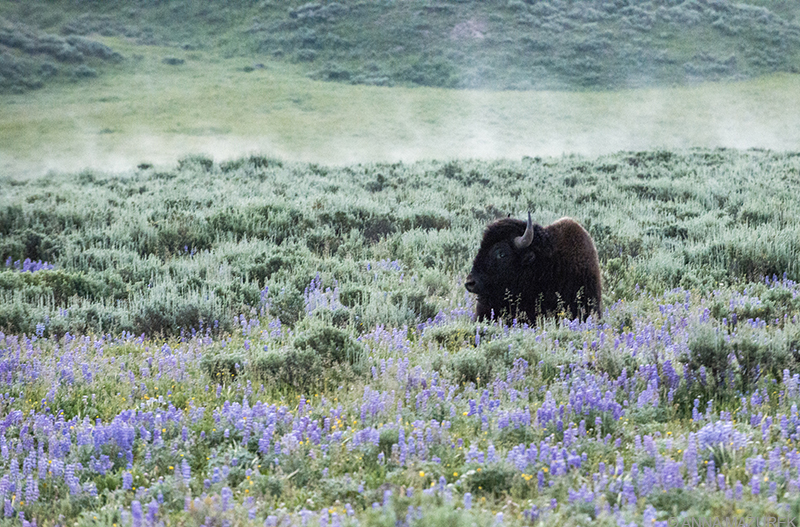
My favorite thing about Yellowstone were the bison. I miss people randomly yelling, “Bison, on the right!”
Overall, Yellowstone was stunning. I’ve never seen so much wildlife anywhere in the world. (Well, except for that time that herd of camels ran out in front of our van in India on the way to the Taj Mahal.) Despite being peak season, it was much easier to escape the crowds than I expected. I’ve put together a photo guide to Yellowstone that includes top sights ad when to go along with budget and photo tips. Enjoy! (For detailed maps of the park, stop by the visitors center to pick up free brochures or visit their Yellowstone National Park website or download the free app.)
Yellowstone’s Top Sites
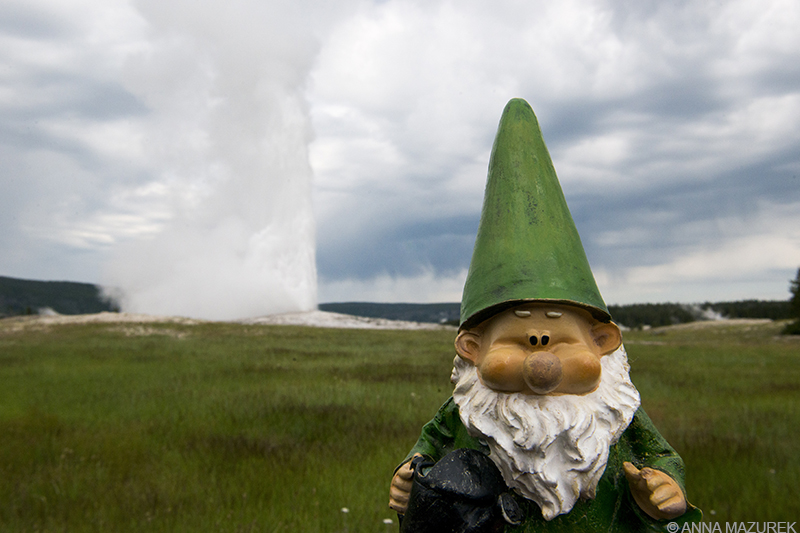
How do you take the perfect gnome photo? Find an iconic spot like Old Faithful here and position Aflred in the foreground. Shoot at a small aperture so both the foreground and background are mostly in focus. I prefer overcast days so his cheeks aren’t too shiny.
Old Faithful
The most well-known site in the park is this cone shaped geyser that ranges from 90 to 184 feet high. It’s the most predictable one in the park. Follow @GeyserNPS on Twitter for latest prediction times. Predicted times will be posted all over the visitor’s center and hotels in the area. Spend an hour or two walking through the maze boardwalks that wind between various geysers and thermal pools in the area including Morning Glory Pool.
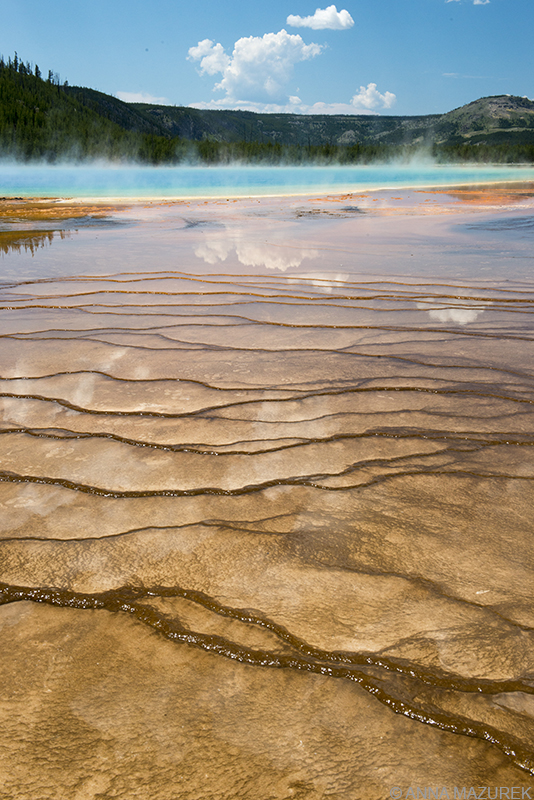
In the early afternoon, Grand Prismatic still had a bit of fog over the pool but great reflections of the clouds.
Grand Prismatic
This colorful hot spring is the largest in the U.S. and third largest in the world. It’s one of the most iconic sites in the park and located in the Midway Geyser Basin a few miles north of Old Faithful. FYI: The Fairy Falls hike that gives you a view above Grand Prismatic is closed for construction as of July.
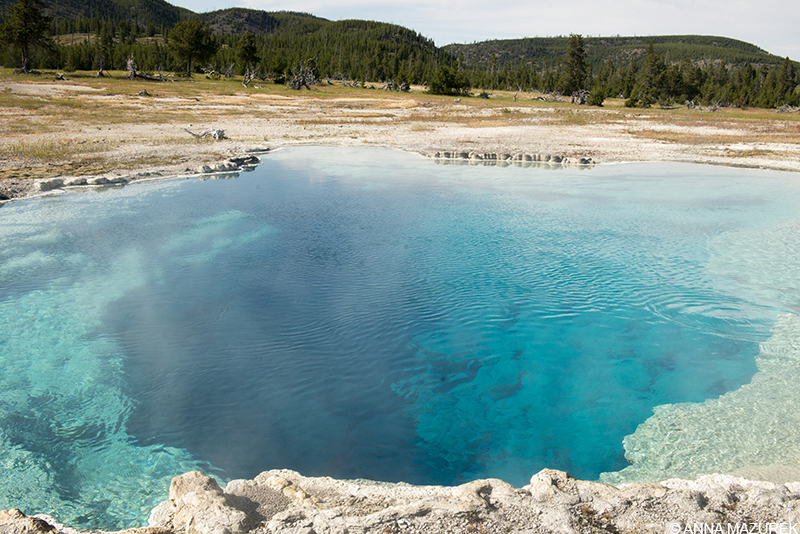
Sapphire Pool at Biscuit Basin
Biscuit Basin
This collection of thermal features including geysers and thermal pools is part of the Upper Geyser Basin. Sapphire Pool, above, is the most photogenic and named for it’s clear blue water. The boardwalk loop is 2/3 of a mile.
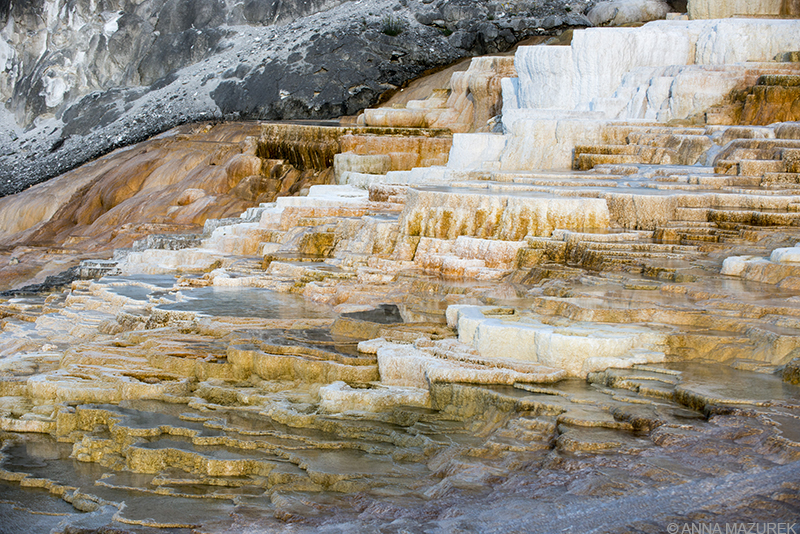
Mammoth Hot Spring is near the northern entrance to the park near Gardiner, Montana.
Mammoth Hot Spring
Located right at the northern entrance to Yellowstone, the stair-step shape of this large hotspring is impressive. The boardwalks are extensive allowing you to view it from all sides, which is good for photography. If the light is bad in one direction, you can always walk to the other side to get a better angle.
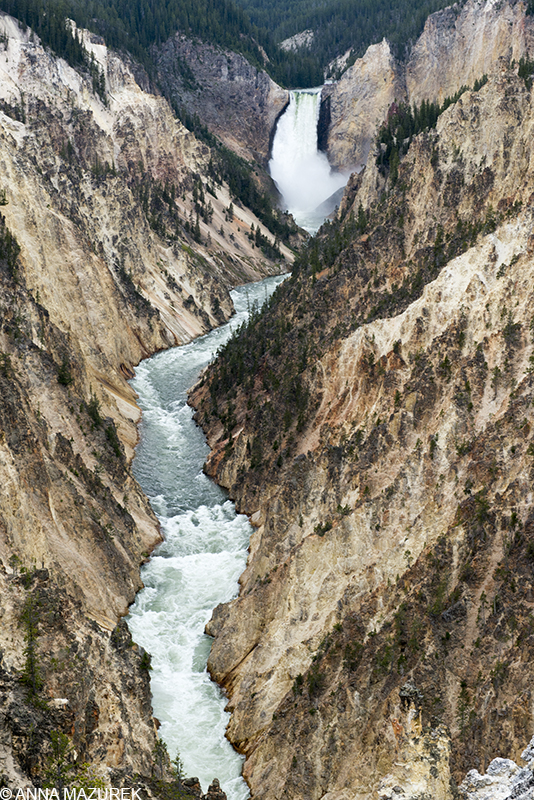
The view of lower Yellowstone Falls from Artist Point
Yellowstone Falls
The lower falls is the largest waterfall in the park at 308-feet tall. It’s the probably the second most photographed site in the park after Old Faithful. The most iconic shot is from Artist Point that gives a great view of the canyon with the waterfall in the distance. (This spot will be PACKED with tourists.) Hike the steep Uncle Tom’s Trail to get a view from the base of the falls, which is significantly less crowded.
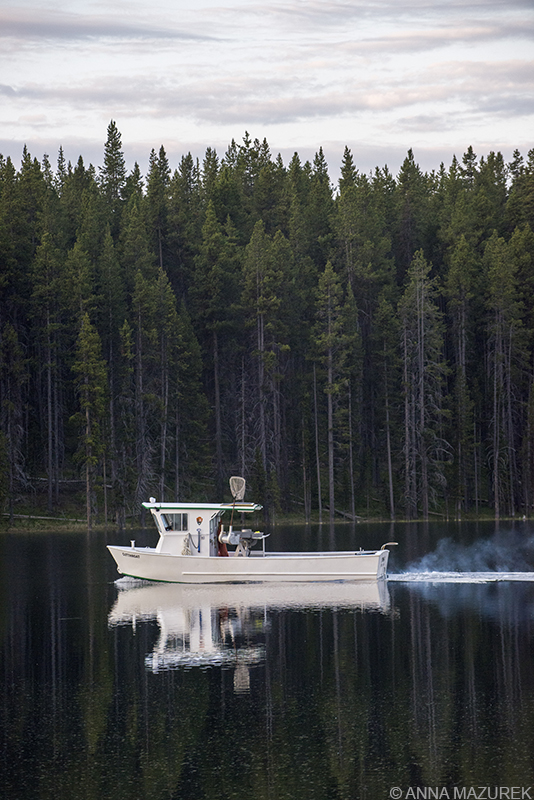 Sunrise at the marina at Yellowstone Lake
Sunrise at the marina at Yellowstone Lake
Yellowstone Lake
At 7,732 feet, the lake is the highest elevation lake in North America. It’s stunning so be sure to take advantage of the many viewpoints to stop for photos. The marina is also great for photos.
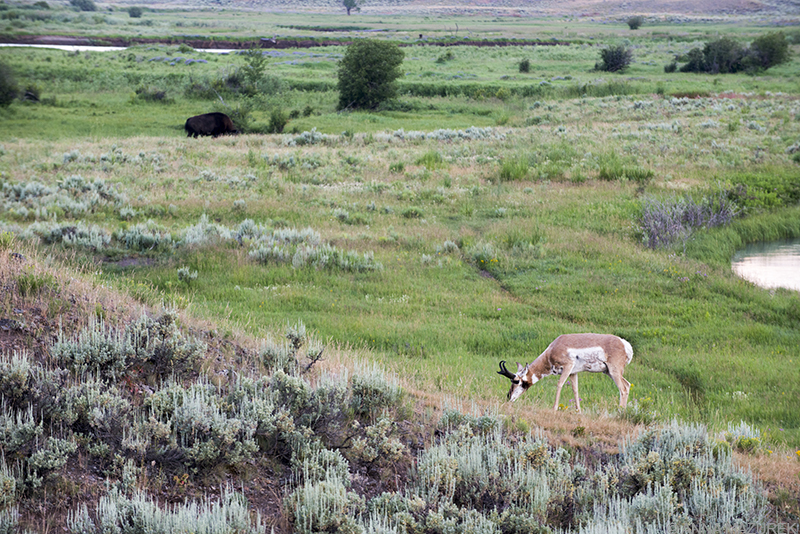
The Lamar Valley was a highlight of my trip. We saw the most animals in this section of the park including pronghorns, bison and baby coyotes.
Lamar Valley
This area is known as the Serengeti of the North America due to the high concentration of animals. The Northern bison herd hangs out in this valley and stretches north to the city of Gardiner. A sunrise drive through this area is a must for any trip. I also recommend taking a Yellowstone Forever guided tour. Our guide, Josh, was a pro at spotting wildlife that no one else noticed and could answer almost any question about the park.
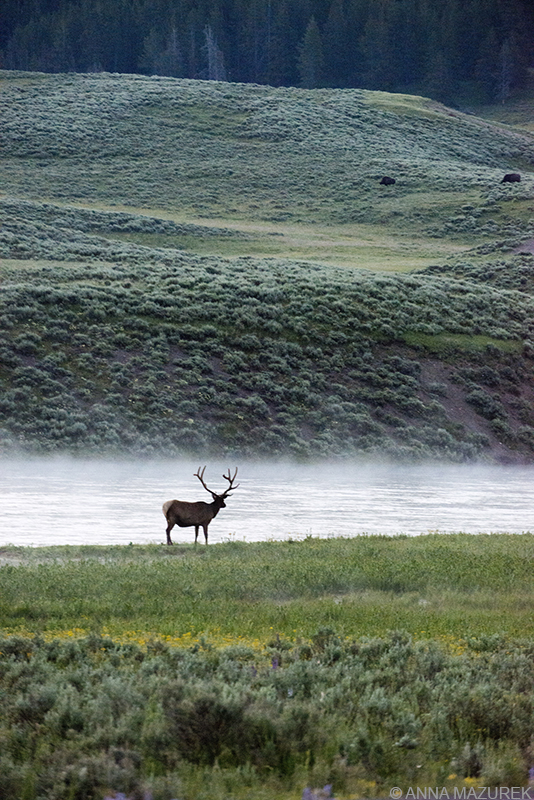
The largest concentration of elk we saw was in the Hayden Valley and along Yellowstone Lake.
Hayden Valley
This is another excellent spot for animal spotting. This area lies between the Yellowstone River and Yellowstone Lake. There’s also a high chance of spotting waterfowl as well. Again, sunrise is a great time for drive through the valley toward the lake. Since there’s plenty of pullouts, it’s easy to even take photos from the car and keep a safe distance from the animals.
How to beat the crowds at Yellowstone
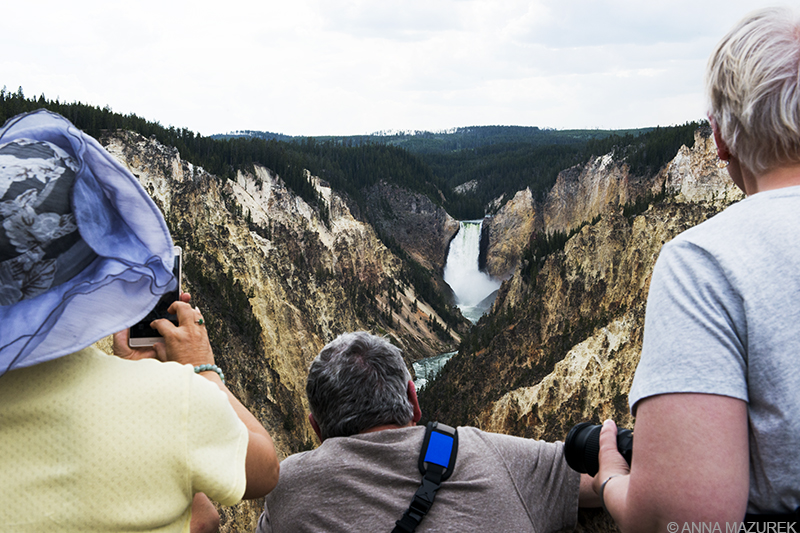
Artist Point and other easy to access locations like Old Faithful will be packed with people. Luckily, it’s easy to exclude them from images but also sometimes interesting to include for context.
Summer is peak season so I was dreading the crowds. I imagined hoards of tour buses and traffic that made rush hour on the 405 in L.A look like an F1 race. I was pleasantly surprised. Yes, there were lines of cars getting into parking lots. The majority of people get fed up and parked all along the roads, which meant that I ALWAYS found rockstar parking in the lots even though I was driving a 15-passenger van! Patience pays off when parking at Yellowstone.
Almost all the major sites in the park were empty before 10 a.m. and after 6 p.m. Sunset was around 9:15 p.m. in July when I was visiting. (The average vacationer isn’t up early and eats dinner around 6 p.m.) I was up at 4:30 a.m. most mornings and shooting until sunset. Honestly, I was seriously shocked how empty the sites were at sunset especially!
Yellowstone Budget Tips
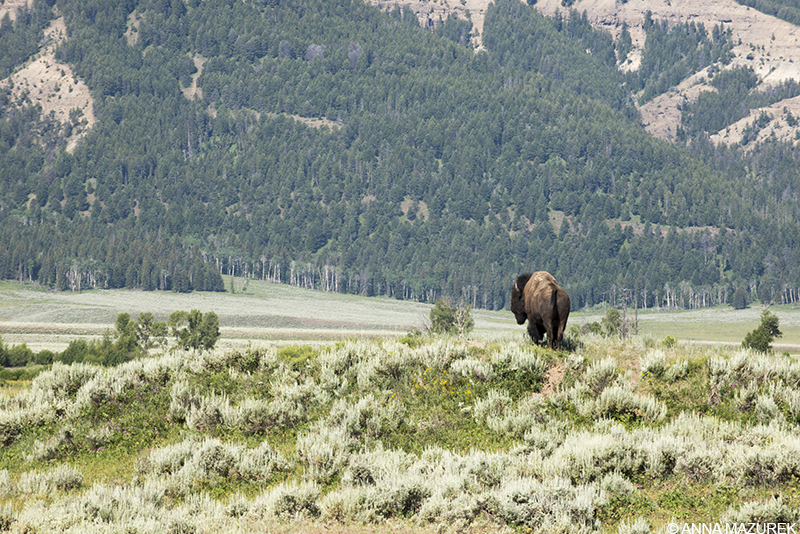
The bison herds in Yellowstone are the only contiguously present geneticly pure herd in the lower 48 states. (Fred, the bison above, lives in the Lamar Valley.)
- Take your own food. There is a lack of variety in food options in the park. The cafeteria restaurants have the exact same menu every day for both lunch and dinner. (The average meal cost without a drink was roughly $10 USD at the cafeterias.) The best restaurant was at the Obsidian Dining Room at the Old Faithful Snow Lodge. I recommend driving to the town of Gardiner at the northern entrance for meals if you run out of food or need some variety.
- Camp: The lodges are nice but expensive. There are 12 regular campgrounds with over 2,000 sites. Five campgrounds can be reserved in advance and the rest and first-come first-serve basis. There are also backcountry camping options. For more info on camping, visit https://www.nps.gov/yell/planyourvisit/campgrounds.htm
- Fee Free Dates: Take advantage of these fee free dates for national parks every year. Normally, the park entrance fee is $30 per car or $50 combo pass for Yellowstone and Grand Teton.
- Buy Gas Outside the Park: As expected, gas is more expensive and harder to find in the park. Fill up in Gardiner or any of the towns outside the park.
Yellowstone Wildlife Photo Tips
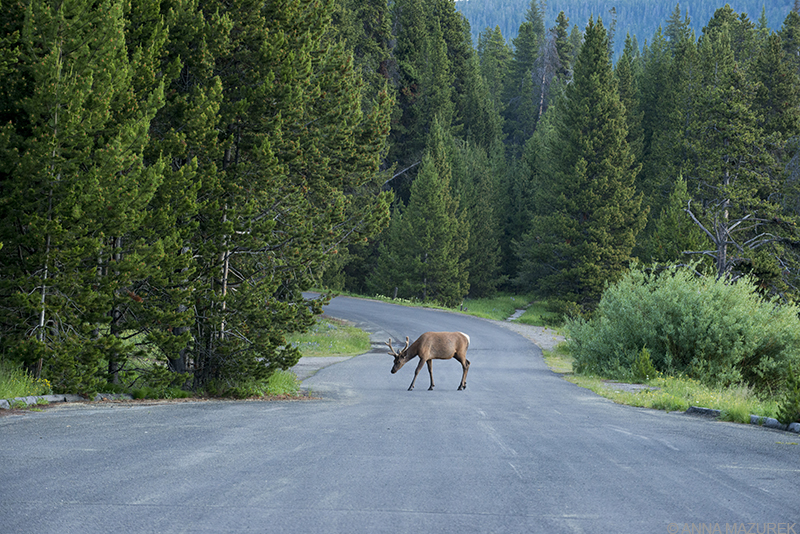
An elk wanders across a small side road by Yellowstone Lake at sunrise.
- The early bird gets the photo. We were in the car and on the road 30 minutes before sunrise almost every day. This is also great for scenic landscape shots as well as animals. The best spots for wildlife are the Lamar Valley and Hayden Valley as mentioned above.
- Be realistic with expectations. The odds of seeing a lynx are less than your odds of winning a toy from one of the arcade machines with the metal arm. You will see a ton of wildlife but aside from bison and elk, most will likely be too far away for your phone photos. We met people who waited seven hours to photograph bears.
- Take a 400mm lens. My 70-200mm lens wasn’t enough for tight animal shots or even including animals in landscapes. Thankfully, I was able to borrow a friend’s 400mm lens but even then, some animals like the baby coyotes we saw were too far away.
- Keep a safe distance. Don’t be a statistic. People get seriously injured every year getting too close to animals. We saw a guy trying to take cell phone photos of an elk and get within three feet of it! Stay at least 100 yards from bears and wolves, and 25 yards from other animals including bison and elk.
- Shoot from your car. I would pull my car over and shoot from the windows to keep a safe distance from the animals.
- Watch your composition. Be aware of your foreground and background with animals shots. Avoid distracting elements like people or cars.
- Get low. To help animals stand out from the background, get low.
- DO NOT BLOCK THE ROADS. If you see a bear and want to take photos, do not be rude and stop/park in the road. It’s not safe and causes horrible traffic problems. Pull over at the next turn off instead.
Best times for Photographing Yellowstone’s Top Sites
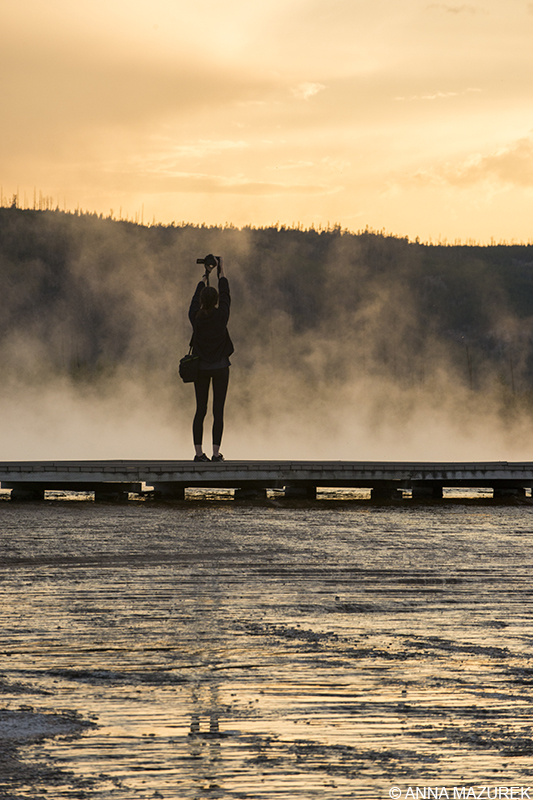
Our goal was to go back to Grand Prismatic at sunset to avoid the fog but a storm rolled. After it cleared, the fog was more intense, which still meant we got amazing photos.
Yellowstone Falls: Mid-morning (9- 10 a.m.) along the south rim of the grand canyon is best to catch light on the falls and possibly get a rainbow.
Obsidian Cliffs: Aim for mid to late afternoon to get the light glinting off the volcanic glass
Grand Prismatic & Thermal Features: For the most dramatic steam on any of our thermal features aim for a cool early morning light. For the best colors aim for a slightly breezy hot late afternoon, especially if you really want to catch the grandeur of the Grand Prismatic. (We went to Grand Prismatic in the early afternoon and the sun was harsh with a bit of fog lingering. We went back at sunset one night after a small storm. The fog was more intense like a horror movie scene but still provided excellent photos like the image above.)
To avoid people: Go before 10 a.m. and after 6 p.m. in the summer. Most tourists sleep in and have dinner around 6 p.m.
Best time to visit Yellowstone
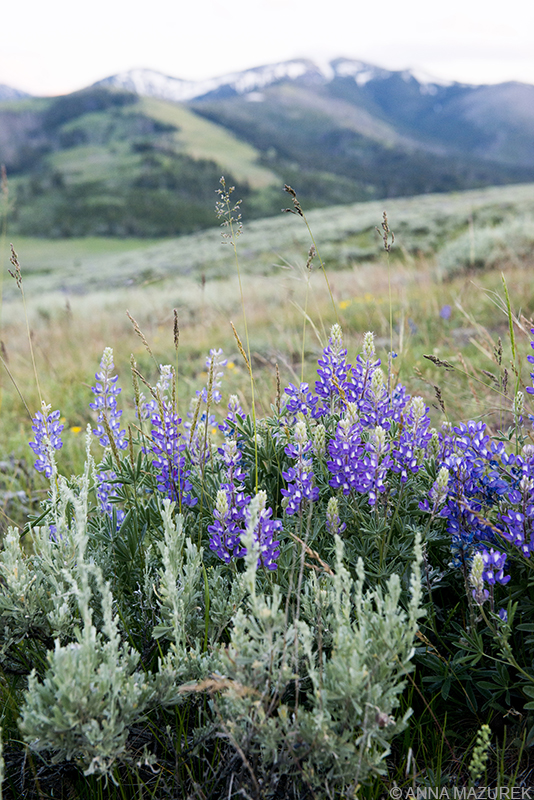
Wildflowers in the Lamar Valley in Yellowstone
For wildlife: Late May to early June before the crowds get here. The bears and babies are everywhere and closer to roads that follow the lower routes through the park meaning less snow and more greens to eat.
For the best snow and high potential for wolves, late January to early February is best.
For flowers or fall colors, mid-June at low elevation and late July at the higher elevations for flowers. Late August for the best fall colors.
__________________________________________
COMING UP:
Interview with the New York Times’ Frugal Traveler
In my next post, I chat with Lucas Peterson, the New York Times’ Frugal Traveler writer. He discusses how he cuts travel costs, his favorite food cities and the biggest myth about budget travel.


